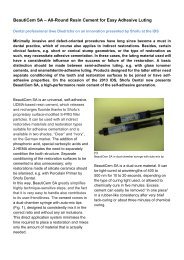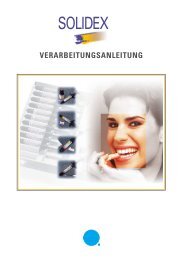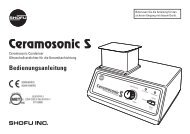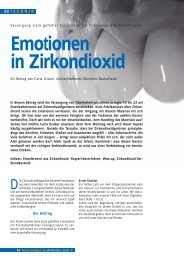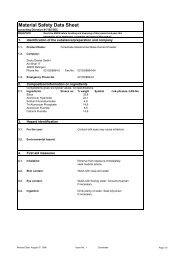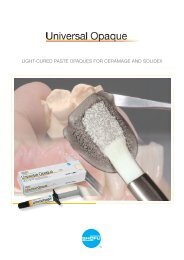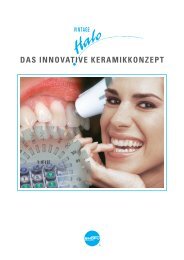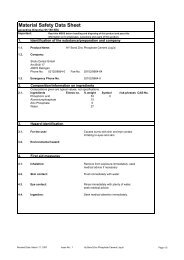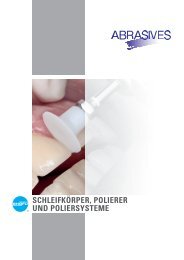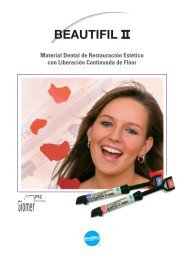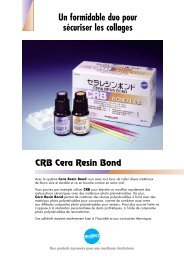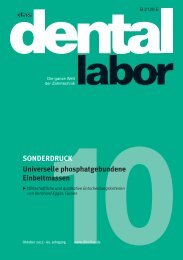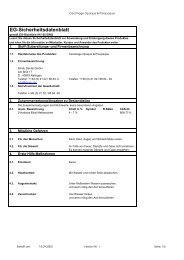gebrauchsanweisung instruction for use vintage al verblendkeramik ...
gebrauchsanweisung instruction for use vintage al verblendkeramik ...
gebrauchsanweisung instruction for use vintage al verblendkeramik ...
Sie wollen auch ein ePaper? Erhöhen Sie die Reichweite Ihrer Titel.
YUMPU macht aus Druck-PDFs automatisch weboptimierte ePaper, die Google liebt.
VINTAGE AL VERBLENDKERAMIK SYSTEM<br />
GEBRAUCHSANWEISUNG<br />
INSTRUCTION FOR USE
1<br />
Hinweise<br />
Allgemeine Hinweise<br />
Während der Bearbeitung und Politur ist das Tragen einer Schutzbrille<br />
empfohlen.<br />
Während der Bearbeitung und Politur ist eine Absaugung er<strong>for</strong>derlich,<br />
um die Inh<strong>al</strong>ation der Schleifstäube zu vermeiden.<br />
Bitte lesen Sie vor Gebrauch von VINTAGE AL diese Verarbeitungsanleitung. Nur<br />
so gewährleisten Sie die korrekte Anwendung der Keramikmassen. Anschließend<br />
bewahren Sie diese Anleitung bitte an einem Ort auf, an welchem Sie leichten<br />
Zugriff haben, um gegebenenf<strong>al</strong>ls etwas nachlesen zu können.<br />
VINTAGE AL wurde <strong>al</strong>s Verblendkeramik für Aluminiumoxidkäppchen, wie z. B.<br />
Procera ® (*), entwickelt. Aufgrund der langjährigen Erfahrung bei der Herstellung<br />
op<strong>al</strong>isierender Keramikmassen lassen sich mit VINTAGE AL rationell natürlich<br />
wirkende Restaurationen anfertigen. Die neuen Cervic<strong>al</strong>-Trans-Massen schaffen<br />
gerade im Zervik<strong>al</strong>bereich eine Farbwiedergabe mit Tiefenwirkung und bilden durch<br />
ihre niedrigere Brenntemperatur glattere Oberflächen, die sich einfacher reinigen<br />
lassen und gewebefreundlicher sind.<br />
(*) Procera ® ist ein eingetragenes Warenzeichen von Nobel Biocare, Schweden.<br />
VINTAGE AL nur für die hier empfohlenen Indikationen verwenden.<br />
VINTAGE AL darf nur von dent<strong>al</strong>em Fachperson<strong>al</strong> angewendet werden.<br />
Vorsichtsmaßnahmen<br />
2<br />
Bei Auftreten <strong>al</strong>lergischer Reaktionen, wie z. B. einer Eruption oder<br />
Hautentzündungen, den Gebrauch des Produktes unverzüglich einstellen<br />
und einen Arzt konsultieren.<br />
Systemkomponenten<br />
2-1. Natürliche Farbwiedergabe<br />
Inh<strong>al</strong>t<br />
1. Hinweise<br />
2. Systemkomponenten<br />
3. Vorbereitung vor der Anwendung<br />
4. Anwendung<br />
5. Besondere Anwendungshinweise für die<br />
verschiedenen Keramikmassen<br />
5-1.VINTAGE AL Margin Porcelain<br />
5-2.VINTAGE AL Cervic<strong>al</strong> Trans<br />
5-3.VINTAGE AL Whitening Set<br />
5-4.VINTAGE AL Correction Porcelain<br />
S.<br />
S.<br />
3<br />
3<br />
S. 12<br />
S. 14<br />
S. 23<br />
S. 26<br />
S. 27<br />
S. 27<br />
(1)<br />
(2)<br />
(3)<br />
Dank eines umfangreichen Angebotes spezieller Effektfarben, wie z.B.<br />
Cervic<strong>al</strong> Trans- oder Op<strong>al</strong>-Transluzenzmassen, können äußerst ästhetische<br />
Restaurationen angefertigt werden.<br />
Natürliche Schmelzeffekte werden bereits mit einer vereinfachten<br />
2-Schichten-Technik durch den Einsatz der Op<strong>al</strong>-Inzis<strong>al</strong>massen<br />
wiedergegeben.<br />
Eine hohe Farbtreue zur ausgewählten Zahnfarbe wird mit Opaque Liner<br />
erzielt, eg<strong>al</strong> welche Farbe der präparierte Zahn aufweist.<br />
2-2. Naturidentische Fluoreszenz<br />
(1)<br />
(2)<br />
Vintage AL ist natürlich fluoreszierend und uranfrei. Desh<strong>al</strong>b sind diese<br />
Massen besonders bioverträglich.<br />
Die Margin- und Cervic<strong>al</strong>-Transmassen sind intensiver fluoreszierend<br />
eingestellt, damit sich leicht Restaurationen mit natürlich wirkenden<br />
Zervik<strong>al</strong>bereichen erzielen lassen.<br />
Hinweise Systemkomponenten<br />
6. Spezifikationen<br />
6-1.Brenndaten<br />
6-2.Technische Daten<br />
S. 28<br />
S. 29<br />
7. Troubleshooting<br />
S. 30<br />
3
2-3. System und Farben<br />
2-4. Komponenten<br />
SYSTEM<br />
Opaque Liner (23 Farben)<br />
5g<br />
Opaque Dentin (9 Farben)<br />
15g und 50g<br />
Margin Porcelain (11 Farben)<br />
15g<br />
FARBEN<br />
A1O, A2O, A3O, A3.5O, A4O, rootAO<br />
B1O, B2O, B3O, B4O, C1O, C2O, C3O, C4O<br />
D2O, D3O, D4O , W1O, W2O, W3O<br />
OM-Y, OM-LP, OM-DP<br />
OD-N, OD-A3, OD-rootA, OD-B2, OD-B4,<br />
OD-C2, OD-C4, OD-D3, OD-W1<br />
CLM, NM, A3M, rootAM, B2M, B4M, C2M,<br />
C4M, D3M, LPM, W1M<br />
Opaque Liner (23 Farben, je 5g)<br />
VINTAGE AL Opaque Liner sind Pastenopaker, die sich leicht in dünnen<br />
Schichten aufragen lassen.<br />
Die Opaque Liner können <strong>al</strong>s Grundfarbe auf die Al2O3-Käppchen<br />
aufgetragen werden. Sie decken den Farbeindruck verfärbter Pfeilerzähne<br />
oder Stiftaufbauten ab. Drei Effektmassen stehen für die farbliche<br />
Modifizierung zur Verfügung.<br />
· OM-Y : Gelblicher Farbton<br />
· OM-LP : Hellrosa Farbton<br />
· OM-DP : Dunkelrosa Farbton<br />
Systemkomponenten<br />
Body (20 Farben)<br />
15g und 50g<br />
Op<strong>al</strong> Porcelain (5 Farben)<br />
15g und 50g<br />
Op<strong>al</strong> Effect (8 Farben)<br />
15g und 50g<br />
Enamel Effect (5 Farben)<br />
15g und 50g<br />
Cervic<strong>al</strong> (4 Farben)<br />
15g und 50g<br />
Cervic<strong>al</strong> Trans (5 Farben)<br />
15g und 50g<br />
Color Effect (8 Farben)<br />
Gum (2 Farben)<br />
Correction (3 Farben)<br />
15g<br />
15g<br />
15g<br />
A1B, A2B, A3B, A3.5B, A4B, rootAB<br />
B1B, B2B, B3B, B4B, C1B, C2B, C3B, C4B,<br />
D2B, D3B, D4B, W1B, W2B, W3B<br />
Op<strong>al</strong> 56, Op<strong>al</strong> 57, Op<strong>al</strong> 58, Op<strong>al</strong> 59, Op<strong>al</strong> 60<br />
Op<strong>al</strong> T, Op<strong>al</strong> SL, Op<strong>al</strong> WE, Op<strong>al</strong> MI, Op<strong>al</strong> OC,<br />
Op<strong>al</strong> AM-R, Op<strong>al</strong> AM-Y, Op<strong>al</strong> AM-V<br />
BT, OT, PT, GT, T-Glass<br />
AC, BC, CC, DC<br />
CT-CL, CT-W, CT-A, CT-B, CT-R<br />
MP, MY, MIv, RED, Y, O, W<br />
Gum-LP, Gum-DP<br />
ADD-ON B, ADD-ON T, CPM Fine<br />
Opaque Dentin (9 Farben, je 15g und 50g)<br />
Opaque Dentine haben die gleiche Farbwirkung wie die Dentinmassen,<br />
verfügen jedoch über eine höhere Opazität.<br />
Sie werden z.B. bei Frontzahnbrücken eingesetzt, wenn für die Keramik<br />
lingu<strong>al</strong>- oder gingiv<strong>al</strong> im Zwischengliedbereich nur begrenzte<br />
Platzverhältnisse zur Verfügung stehen.<br />
· OD-N : Diluent-Keramik dient zum Aufhellen und wird einfach den<br />
Standard Opaque Dentinen beigemischt.<br />
· OD-W1 : Zur Reproduktion von Whitening Farben<br />
Margin (Schultermassen) (11 Farben, je 15g)<br />
Marginmassen haben die gleiche Farbeinstellung wie die Dentinmassen. Sie<br />
werden jedoch höher gebrannt und verfügen über eine höhere Fluoreszenz.<br />
Sie können zur Korrektur der Randbereiche der Al2O3-Keramikkäppchen<br />
oder zum Aufbau von keramischen Schultern verwendet werden.<br />
· CLM : Transparente Masse kann pur oder zum Untermischen mit den<br />
Standard-Schultermassen zum Erreichen der gewünschten<br />
Transparenz verwendet werden<br />
· NM : Gleiche Farbe wie die Aluminiumoxidkäppchen, wird für die<br />
Korrektur von Randbereichen und das Abtönen der<br />
Schultermassen verwendet<br />
· LPM : Hellrosa Farbton zum Beimischen der Schultermassen<br />
· W1M : Zur Reproduktion von Whitening Farben<br />
Body (20 Farben, je 15g und 50g)<br />
Mit diesen Keramikmassen werden die Dentinfarben wiedergegeben.<br />
Systemkomponenten<br />
4<br />
Op<strong>al</strong> (5 Farben, je 15g und 50g)<br />
Diese Inzis<strong>al</strong>massen sorgen für eine Lichttransmission wie beim natürlichen<br />
Zahnschmelz (Op<strong>al</strong>eszenz).<br />
In zwei Schichten aufgetragen, ergänzend zur Dentinmasse, lassen sich mit<br />
diesen Keramikmassen einfach natürlich wirkende Schmelzfarben erzielen.<br />
5
2-4. Komponenten 2-4. Komponenten<br />
Op<strong>al</strong> Effect (8 Farben, je 15g und 50g)<br />
Diese Inzis<strong>al</strong>-Effektmassen sorgen für eine natürlich wirkende<br />
Lichttransmission im Inzis<strong>al</strong>bereich.<br />
· OPAL T : Standard op<strong>al</strong>isierende Transluzenzmasse<br />
· OPAL SL (Superlucent) : Leicht bläuliche Transluzenzmasse<br />
mit höherer Op<strong>al</strong>eszenz<br />
· OPAL WE (White Enamel) : Etwas weißlich-trübe Keramikmasse<br />
für Rand- oder Approxim<strong>al</strong>bereiche<br />
· OPAL MI (Milky) : Milchig wirkende Keramikmasse<br />
für die Reproduktion der Molaren-Höcker oder weißlicher Zonen<br />
· OPAL AM-R (Amber Red) : Rötlich-orangefarbene<br />
Transluzenzmasse zur Wiedergabe der Schmelzeffekte<br />
· OPAL AM-Y (Amber Yellow) : Gelblich-orangefarbene<br />
Transluzenzmasse zur Reproduktion von Schmelzeffekten<br />
· OPAL AM-V (Amber Violet) : Leicht lila-orangefarbene<br />
Keramikmasse für die Reproduktion von Schmelzeffekten<br />
· OPAL OC (Occlus<strong>al</strong>) : Leicht-trübe Keramikmasse für die Anwendung<br />
im Okklus<strong>al</strong>bereich<br />
Color Effect (8 Farben, je 15g)<br />
Diese Effektmassen können pur oder vermischt mit Dentinmassen<br />
verwendet werden.<br />
· MP (Mamelon Pink) :<br />
Rosafarbene, intensive Keramikmasse für den Aufbau von Mamelons<br />
jugendlicher Zähne im Inzis<strong>al</strong>bereich<br />
· MIv (Mamelon Ivory) :<br />
Elfenbeinfarbene, intensive Keramikmasse für den Aufbau von Mamelons<br />
für Patienten mittleren Alters im Inzis<strong>al</strong>bereich<br />
· MY (Mamelon Yellow) :<br />
Gelblich, intensive Keramikmasse für den Aufbau von Mamelons für ältere<br />
Patienten im Inzis<strong>al</strong>bereich<br />
· RED (Red)<br />
· Y (Yellow)<br />
· O (Orange)<br />
· G (Grey)<br />
· W (White)<br />
: Rosafarbene Effektmasse<br />
: Gelbliche Effektmasse<br />
: Orangefarbene Effektmasse<br />
: Gräuliche Effektmasse<br />
: Weißliche Effektmasse<br />
Enamel Effect (5 Farben, je 15g und 50g)<br />
Transluzente Effektmassen ohne Op<strong>al</strong>eszenz<br />
· BT (Blau Transluzent) : Bläuliche Transluzenzmasse<br />
· OT (Orange Transluzent) : Orangefarbene Transluzenzmasse<br />
· PT (Pink Transluzent) : Rosafarbene Transluzenzmasse<br />
· GT (Grau Transluzent) : Gräuliche Transluzenzmasse<br />
· T-Glass : Hoch transparente, glasklare Keramikmasse<br />
Gum (2 Farben, je 15g)<br />
Diese rosafarbenen Keramikmassen dienen zur Wiedergabe der Gingiva.<br />
Aufgrund der niedrigeren Brenntemperatur können sie nach dem<br />
Aufbrennen der Standardmassen gebrannt werden.<br />
· Gum-LP (Light pink) : Hellrosafarbene Gingiva-Masse<br />
· Gum-DP (Dark pink) : Dunkelrosafarbene Gingiva-Masse<br />
Systemkomponenten<br />
6<br />
Cervic<strong>al</strong> (4 Farben, je 15g und 50g)<br />
Zervik<strong>al</strong>massen zur Wiedergabe zervik<strong>al</strong>er Farbtöne. Durch Beimischen zu<br />
den Dentinmassen werden besonders intensive Farbtöne, wie z. B. A4 oder<br />
B4 wirkungsvoller erreicht.<br />
Cervic<strong>al</strong> Trans (Transluzente Zervik<strong>al</strong>massen) (5 Farben, je 15g und 50g)<br />
Mit Cervic<strong>al</strong> Trans reproduziert man Farben mit tieferer Transluzenz im<br />
Zervik<strong>al</strong>bereich und schafft glatte Oberflächen für eine bessere<br />
Gewebeverträglichkeit.<br />
Sie werden etwas niedriger gebrannt <strong>al</strong>s die Dentinmassen und sind<br />
fluoreszierender.<br />
· CT-CL<br />
· CT-W<br />
· CT-A<br />
· CT-B<br />
· CT-R<br />
:<br />
:<br />
:<br />
:<br />
:<br />
Transluzente Keramikmasse<br />
Leicht weißlich transluzente Masse zur Schaffung weißlicher<br />
Zervik<strong>al</strong>bereiche<br />
Orange transluzente Masse die, mit CT-CL gemischt, für die<br />
Wiedergabe der A-Farben angewendet wird<br />
Gelblich transluzente Masse die, mit CT-CL gemischt, für die<br />
Wiedergabe der B-Farben angewendet wird<br />
Rötlich transluzente Masse die, mit CT-CL gemischt, für die<br />
Wiedergabe der R-Farben* angewendet wird<br />
* VINTAGE HALO Red-Sfift-Farbring<br />
Correction (3 Farben, je 15g)<br />
Können in kleinen Mengen für die Korrektur nach der Konturierung oder<br />
nach der Glasur verwendet werden.<br />
· ADD-ON B : Korrekturmasse für Dentin, Farbe A3B<br />
· ADD-ON T : Transluzente Korrekturmasse für Schmelzbereiche<br />
· CPM Fine : Feinkörniger <strong>al</strong>s ADD-ON B. Wird verwendet für die Korrektur<br />
des Randschlusses nach der Glasur<br />
VINTAGE AL OPAQUE LINER LIQUID (3ml)<br />
Zum Anmischen des Opaque Liners und Modifizieren der Pastenkonsistenz.<br />
VINTAGE-MODELLING LIQUID (50ml, 500ml)<br />
Flüssigkeit zum Anmischen der VINTAGE-Keramikmassen<br />
(außer Opaque Liner).<br />
Sie verhindert das schnelle Austrocknen der angerührten Massen und<br />
verbessert die Verarbeitungseigenschaften beim Schichtaufbau.<br />
7<br />
Systemkomponenten
VINTAGE AL Margin Porcelain Set<br />
13 Farben<br />
Zubehör<br />
Margin (10 Farben / 15g)<br />
Effect (1 Farbe / 15g)<br />
Correction (2 Farben / 15g)<br />
: CLM, NM, A3M, rootAM, B2M, B4M, C2M, C4M,<br />
D3M, W1M<br />
: LPM<br />
: ADD-ON B, CPM Fine<br />
VINTAGE CPM MODELLING LIQUID (1 Flasche / 3ml)<br />
VINTAGE MARGIN PORCELAIN ISOLATION LIQUID (1 Stift / 7ml)<br />
VINTAGE AL Color Effect Set<br />
Opaque Liner Effect (3 Farben / 5g)<br />
Color Effect (8 Farben / 15g)<br />
Gum (2 Farben / 15g)<br />
13 Farben<br />
: OM-Y, OM-LP, OM-DP<br />
: MP, MY, MIv, RED, Y, O, G, W<br />
: Gum-LP, Gum-DP<br />
VINTAGE AL/ZR OPAQUE LINER LIQUID<br />
VINTAGE MODELLING LIQUID<br />
VINTAGE CPM MODELLING LIQUID<br />
VINTAGE MARGIN ISOLATION LIQUID, Stift<br />
VINTAGE PORCELAIN ISOLATION LIQUID, Flasche (10ml)<br />
VINTAGE AL COLOR INDICATOR (7 Stück)<br />
Opaque Liner<br />
Body<br />
Enamel (Op<strong>al</strong> Porcelain, Op<strong>al</strong> Effect, Enamel Effect)<br />
Margin<br />
Opaque Dentin<br />
Color Effect (Opaque Liner Effect, Color Effect)<br />
Cervic<strong>al</strong>, Cervic<strong>al</strong> Trans, Correction<br />
SHOFU DIE COLOR CHECKER<br />
(Lichthärtendes Komposit zur Kontrolle der Stumpffarbe)<br />
SHOFU DIE COLOR CHECKER (7 Farben)<br />
SHOFU DIE COLOR CHECKER INDIKATOR (1 Set)<br />
SHOFU DIE STICK (30 Stück)<br />
VINTAGE PORCELAIN ISOLATION LIQUID (10ml)<br />
UNI BRUSH No. 1 (1 Stück)<br />
(3ml)<br />
(50ml, 500ml)<br />
(3ml)<br />
(7ml)<br />
Einzelprodukte<br />
Systemkomponenten<br />
Opaque Liner<br />
Margin<br />
Opaque Dentin<br />
Body<br />
Op<strong>al</strong><br />
Op<strong>al</strong> Effect<br />
Enamel Effect<br />
Color Effect<br />
Cervic<strong>al</strong><br />
Cervic<strong>al</strong> Trans<br />
Gum<br />
Correction<br />
(23 Farben / 5g)<br />
(11 Farben / 15g)<br />
( 9 Farben / 15g, 50g)<br />
(20 Farben / 15g, 50g)<br />
( 5 Farben / 15g, 50g)<br />
( 8 Farben / 15g, 50g)<br />
( 5 Farben / 15g, 50g)<br />
( 8 Farben / 15g)<br />
( 4 Farben / 15g, 50g)<br />
( 5 Farben / 15g, 50g)<br />
( 2 Farben / 15g)<br />
( 3 Farben / 15g)<br />
Systemkomponenten<br />
10<br />
11
3<br />
Vorbereitung<br />
3-1. Vorbereitung vor der Anwendung<br />
Bei Verwendung von Procera ® -Käppchen<br />
Bei Verwendung anderer Aluminiumoxid-Gerüste<br />
Sob<strong>al</strong>d das Procera ® -Käppchen korrigiert ist, mit<br />
Aluminiumoxid (ca. 50 µm) bei einem Druck von<br />
2-3 bar abstrahlen oder die Oberfläche in einem<br />
Ultrasch<strong>al</strong>lbad reinigen. Dann nach folgender<br />
Brenntabelle brennen.<br />
Werden andere Aluminiumoxid-Käppchen<br />
verwendet, wie z. B. Glasinfiltrations- oder<br />
Folienmatritzenkäppchen, befolgen Sie bitte die<br />
Anleitungen des betreffenden Herstellers.<br />
Beschleifen mit diamantierten<br />
Schleifkörpern. Bitte beachten:<br />
Zu viel Druck, grobe<br />
Schleifkörper und hochtouriges<br />
Schleifen führen zu<br />
Abplatzungen und Sprüngen.<br />
Hinweis VINTAGE AL ist farblich auf Procera ® -<br />
Käppchen abgestimmt.<br />
Bei Verwendung anderer Gerüstsysteme<br />
wählen Sie die hellstmögliche Einfärbung<br />
(so weiß wie möglich).<br />
Nach Auftragen von VINTAGE<br />
PORCELAIN ISOLATION LIQUID<br />
füllen Sie DIE CHECKER<br />
Komposit in das Käppchen,<br />
platzieren den Stift und härten<br />
mit Licht.<br />
SHOFU DIE COLOR CHECKER<br />
Atmosphärischer Brand<br />
Formgebung und Ausarbeiten<br />
mit dem CeraMaster Coarse<br />
(diamantimprägnierter Polierer)<br />
Das passende DIE COLOR CHECKER Komposit<br />
zur präparierten Stumpffarbe auswählen, das<br />
Materi<strong>al</strong> in das isolierte Käppchen füllen und<br />
lichthärten. Die Farbüberprüfung erfolgt mit dem<br />
Stumpfmodell.<br />
(Nähere Details entnehmen Sie bitte der<br />
DIE COLOR CHECKER Anleitung)<br />
Nach der Aushärtung entfernen<br />
Sie das Käppchen.<br />
650 o C 50~60 o C / Min. 1000 o C H<strong>al</strong>tezeit 5 Min.<br />
Vorwärmen von Procera ® -Käppchen<br />
Vorbereitung<br />
Procera ® ist ein eingetragenes Warenzeichen<br />
von Nobel Biocare AB, Schweden.<br />
Hinweis<br />
Farbe nach dem Vorwärmen<br />
(rechts: danach)<br />
Procera ® -Käppchen färben sich weißlich nach dem Vorwärmen.<br />
Um eine Überhitzung der Procera ® -Käppchen während der<br />
Bearbeitung zu vermeiden, kühlen Sie mit Wasser und schleifen mit<br />
niedriger Drehzahl.<br />
Der Stumpf zur Farbkontrolle<br />
Vorbereitung<br />
12<br />
13
4<br />
Anwendung<br />
4-1. VINTAGE AL Farbtabellen<br />
Tabelle 1 – Basis Farben<br />
Farbe A1 A2 A3 A3.5 A4 rootA<br />
Opaque Liner A1O A2O A3O A3.5O A4O rootAO<br />
Cervic<strong>al</strong> - - A3B : 2 A3.5B : 1 A4B : 1<br />
AC : 1 AC : 1 AC : 1<br />
AC<br />
Body A1B A2B A3B A3.5B A4B rootAB<br />
Op<strong>al</strong> 57 58 59 59 : 1<br />
60 : 1<br />
60 60<br />
Farbe<br />
Opaque Liner<br />
Cervic<strong>al</strong><br />
Body<br />
Op<strong>al</strong><br />
Farbe<br />
Opaque Liner<br />
Cervic<strong>al</strong><br />
Body<br />
Op<strong>al</strong><br />
B1 B2 B3 B4<br />
B1O B2O B3O B4O<br />
- - B3B : 1<br />
BC : 1<br />
BC<br />
B1B B2B B3B B4B<br />
57 58 59 60<br />
C1 C2 C3 C4<br />
C1O C2O C3O C4O<br />
- C2B : 2 C3B : 1<br />
CC : 1 CC : 1<br />
CC<br />
C1B C2B C3B C4B<br />
58 58 59 60<br />
Tabelle 2 – Whitening Farben<br />
Farbe W1 W2 W3<br />
Opaque Liner W1O W2O W3O<br />
D2<br />
D2O<br />
D2B : 1<br />
DC : 1<br />
D2B<br />
58<br />
D3<br />
D3O<br />
D3B : 1<br />
DC : 1<br />
D3B<br />
59<br />
D4<br />
D4O<br />
DC : 2<br />
BC : 1<br />
D4B<br />
59<br />
Tabelle 3 - Opaque Dentin Farben<br />
Farbe<br />
A<br />
B<br />
C<br />
D<br />
W<br />
1 2 3 3.5 4 root<br />
OD-N<br />
OD-N : 1<br />
OD-A3 : 2 OD-A3 : 1<br />
OD-A3<br />
OD-A3 : 1<br />
OD-rootA : 1 OD-rootA : 2<br />
OD-rootA<br />
OD-N : 1<br />
OD-B2 : 1<br />
OD-B2<br />
OD-B2 : 1<br />
OD-B4 : 1<br />
- OD-B4 -<br />
OD-N : 1<br />
OD-C2 : 1<br />
OD-C2<br />
OD-C2 : 1<br />
OD-C4 : 1<br />
- OD-C4 -<br />
-<br />
OD-N : 1<br />
OD-D3<br />
OD-D3 -<br />
: 1<br />
OD-D3 : 1<br />
OD-B4 : 1<br />
-<br />
OD-W1 : 2 OD-W1 : 1<br />
OD-W1<br />
OD-N1 : 1 OD-N1 : 2<br />
- -<br />
-<br />
Tabelle 4 - Margin Farben<br />
Farbe 1 2 3 3.5 4 root<br />
A NM NM : 1 A3M A3M : 2 A3M : 1 rootAM<br />
A3M : 1<br />
rootAM : 1 rootAM : 2<br />
B<br />
C<br />
D<br />
W<br />
NM : 1<br />
B2M : 1<br />
NM : 1<br />
C2M : 1<br />
-<br />
W1N<br />
B2M<br />
C2M<br />
NM : 1<br />
D3M : 1<br />
W1N : 2<br />
NW : 1<br />
B2M : 1<br />
B4M : 1<br />
C2M : 1<br />
C4M : 1<br />
D3M<br />
W1N : 1<br />
NW : 2<br />
-<br />
-<br />
B4M<br />
C4M<br />
-<br />
D3M : 1<br />
B4M : 1<br />
- -<br />
-<br />
-<br />
-<br />
-<br />
Anwendung<br />
Cervic<strong>al</strong><br />
Body<br />
Op<strong>al</strong><br />
- - -<br />
W1B<br />
56<br />
W2B<br />
56 : 2<br />
57 : 1<br />
W3B<br />
56 : 1<br />
57 : 2<br />
Anwendung<br />
14<br />
15
4-2. Schichtschema<br />
Basisschichtung 1 (mit Opaque Liner)<br />
Im F<strong>al</strong>le von verfärbten Stümpfen oder bei Stiftaufbauten ist das Auftragen<br />
von Opaque Liner er<strong>for</strong>derlich.<br />
Dadurch erhält das Al2O3-Käppchen seine Grundfarbe.<br />
Enamel<br />
Body<br />
Opaque Liner<br />
Cervic<strong>al</strong><br />
Aluminiumoxidkäppchen<br />
4-3. Basisschichtung<br />
Mit der Anwendung von Opaque Liner<br />
(1) Erster Opaque-Liner-Auftrag<br />
Im F<strong>al</strong>l von verfärbten Stümpfen oder<br />
vorhandenen Stiftaufbauten sollten die<br />
dunklen Bereiche mit Opaque Liner<br />
abgedeckt werden. Tragen Sie Opaque Liner<br />
auf das gesamte Al2O3-Käppchen auf und<br />
brennen.<br />
(2) Zweiter Opaque-Liner-Auftrag<br />
Nach dem Brand der ersten<br />
Opaque-Liner-Schicht eine zweite Schicht<br />
zum Abdecken des Al2O3-Käppchens<br />
auftragen und brennen.<br />
Opaque-Liner-Auftrag<br />
Schichtaufbau mit Opaque Liner<br />
Beachten<br />
Damit sich die Flüssigkeit im Opaque Liner nicht<br />
absondert, immer vor dem Gebrauch umrühren.<br />
Im F<strong>al</strong>le von Blasenbildung gehen Sie wie folgt vor:<br />
Vermeiden Sie das Auftragen von Opaque Liner in<br />
dicken Schichten.<br />
Trocknen Sie gründlich vor dem Brand.<br />
Vermeiden Sie ein Platzieren der Käppchen auf<br />
einem heißen Brenngutträger.<br />
Gebrannter Opaque Liner<br />
Basisschichtung 2 (ohne Opaque Liner)<br />
Wenn keine verfärbten Stümpfe vorhanden sind, schichten Sie, ohne zuvor<br />
Opaque Liner aufzutragen, Cervic<strong>al</strong> Keramik dünn auslaufend von zervik<strong>al</strong><br />
nach inzis<strong>al</strong>. Für dunklere Farbgebungen können zuvor Stains (M<strong>al</strong>farben)<br />
aufgetragen und durch Brennen fixiert werden.<br />
Enamel<br />
(3) Cervic<strong>al</strong>-Brand<br />
Cervic<strong>al</strong> Keramik im Zervik<strong>al</strong>bereich<br />
auftragen und brennen.<br />
Cervic<strong>al</strong>-Auftrag<br />
Anwendung<br />
Body<br />
Aluminiumoxidkäppchen<br />
Cervic<strong>al</strong><br />
Schichtaufbau ohne Opaque Liner<br />
Hinweis<br />
Procera ® -Gerüste sollten vorgewärmt<br />
werden.<br />
Die Basisfarbe von Opaque Liner kann<br />
durch Verwendung von SHOFU<br />
M<strong>al</strong>farben (Farben Nr. 41 – 49)<br />
optimiert werden.<br />
Nach Brand der<br />
Cervic<strong>al</strong>- Masse<br />
Anwendung<br />
16<br />
17
Schichtaufbau ohne Opaque Liner<br />
(1) Auftragen der Cervic<strong>al</strong> Keramikmassen<br />
Bei nicht verfärbten Stümpfen kann ohne Opaque Liner gearbeitet werden.<br />
In diesen Fällen wird Cervic<strong>al</strong> Keramik von zervik<strong>al</strong> bis zur Schneidekante<br />
dünn auslaufend aufgetragen. Für dunklere Farbgebungen können zuvor<br />
Stains (M<strong>al</strong>farben) aufgetragen und durch Brennen fixiert werden.<br />
(2) Zurückschneiden der Body-Masse<br />
Schneiden Sie nun Teile des Dentinkörpers<br />
zurück, um ausreichend Platz für die<br />
Inzis<strong>al</strong>massen zu schaffen.<br />
Schneiden Sie zunächst vom oberen Drittel<br />
zur Inzis<strong>al</strong>kante zurück<br />
Das zweite Drittel reduzieren Sie von labi<strong>al</strong><br />
Auftragen der M<strong>al</strong>farbe<br />
Nach dem M<strong>al</strong>farbenauftrag<br />
Anschließend trennen Sie interproxim<strong>al</strong><br />
4-4. Auftrag und Brand der Body- und Inzis<strong>al</strong>massen<br />
(1) Auftragen der Body-Masse<br />
Body-Masse auftragen und verdichten.<br />
Die Form sollte mit dem Nachbarzahn harmonieren.<br />
Gest<strong>al</strong>ten Sie die fingerförmige<br />
Mamelonstruktur<br />
Anwendung<br />
Auftragen der Body-Masse<br />
Die korrekte Dentin<strong>for</strong>m<br />
Anwendung<br />
Hinweis<br />
Auftragen der Body-Masse<br />
Wir empfehlen, diese Keramikmasse etwas mehr <strong>al</strong>s<br />
Met<strong>al</strong>lkeramikmassen zu verdichten.<br />
18<br />
19
(3) Auftragen der Op<strong>al</strong>-Masse<br />
Der Auftrag der Op<strong>al</strong>-Masse muss<br />
überdimensioniert erfolgen, um den<br />
Brandschwund auszugleichen.<br />
(4) Aufbau der Approxim<strong>al</strong>bereiche<br />
Heben Sie die Krone vom Modell ab, tragen<br />
Sie Op<strong>al</strong>-Masse auf die Approxim<strong>al</strong>bereiche<br />
auf und verdichten diese.<br />
Das Abdecken der ganzen Fläche<br />
(inklusive Approxim<strong>al</strong>bereiche) mit<br />
Op<strong>al</strong>-Masse führt zu einer natürlich<br />
wirkenden Farbgebung.<br />
Auftragen der<br />
Approxim<strong>al</strong>bereiche<br />
Die Schneidekante lingu<strong>al</strong> zurückschneiden,<br />
um den Dentinbereich korrekt zu <strong>for</strong>men.<br />
Hinweis<br />
Bitte tragen Sie<br />
Op<strong>al</strong>-Inzis<strong>al</strong>massen auf die<br />
labi<strong>al</strong>en/lingu<strong>al</strong>en<br />
Schneideflächen sowie auf<br />
die aproxim<strong>al</strong>en Flächen<br />
auf. Das Abdecken der<br />
gesamten Oberfläche mit<br />
Op<strong>al</strong>-Masse schafft<br />
eine Tiefenwirkung und<br />
Transluzenz der Farbe.<br />
Beachten<br />
Die abgebildete Keramikmasse ist stärker pigmentiert <strong>al</strong>s die tatsächlichen Massen.<br />
Dies ermöglicht eine leicht erkennbare Lage der korrekt platzierten Einzelschichten.<br />
Anwendung<br />
20<br />
Hinweis<br />
Bauen Sie anschließend die reduzierte<br />
lingu<strong>al</strong>e Inzis<strong>al</strong>kante mit Op<strong>al</strong>-Masse auf.<br />
Zurückschneiden der lingu<strong>al</strong>en<br />
Schneidekante<br />
Bitte stellen Sie sicher, dass sich die<br />
Body- und Inzis<strong>al</strong>masse nicht<br />
vermischen. Diese sollen <strong>al</strong>s separate<br />
Schichten erkennbar sein. Sollten die<br />
Schichten nicht separat platziert sein<br />
oder sich miteinander vermischt haben,<br />
weist der Inzis<strong>al</strong>bereich keine korrekte<br />
Transluzenz auf.<br />
21<br />
Anwendung
5<br />
Besondere Anwendungshinweise für die verschiedenen Keramikmassen<br />
5-1. VINTAGE AL – Margin-Masse<br />
(5) Brandvorbereitungen<br />
Nachdem die Krone fertig aufgebaut wurde,<br />
korrigieren Sie die Form und entfernen<br />
zervik<strong>al</strong> übermodellierte Keramikmasse mit<br />
einem trockenen Pinsel.<br />
Anschließend reinigen Sie die Krone von<br />
innen und brennen diese.<br />
Die VINTAGE AL Margin-Masse wird für die Formkorrektur von<br />
Al2O3-Käppchen verwendet. Mit ihr lassen sich weißliche Ränder entlang der<br />
Al2O3-Kronenkäppchen beseitigen und die erwünschte margin<strong>al</strong>e Farbe<br />
mühelos erzielen.<br />
Anfertigung von Procera ® -Käppchen für Keramikschultern<br />
Standardmethode<br />
(6) Konturierung<br />
Bitte konturieren Sie die Krone nach dem<br />
Brand mit Dura-Green-Schleifkörpern<br />
und/oder CeraMaster-Silikonpolierern. Bei<br />
Bedarf können Sie mit VINTAGE-M<strong>al</strong>farbe<br />
den Farbton vor dem Glasurbrand<br />
korrigieren.<br />
Innenreinigung<br />
Nehmen Sie eine Ab<strong>for</strong>mung vom Arbeitsmodell und fertigen einen<br />
Duplikatstumpf aus Hartgips an. Beschleifen Sie den Randbereich des<br />
Stumpfmodells mit einem Hartmet<strong>al</strong>lbohrer und scannen Sie die neue<br />
Präparationsgrenze ein.<br />
Konturierungsmethode<br />
Kürzen Sie den Randbereich der Procera ® -Kappe mit einem Schleifkörper,<br />
wie z. B. CeraMaster Coarse.<br />
Korrektur des Käppchens<br />
Der Rand sollte kürzer sein <strong>al</strong>s die für die Käppchenanfertigung<br />
eingescannten Standard-Daten. Korrigieren Sie desh<strong>al</strong>b nach dem<br />
Scannen die Daten für den Kronenrand manuell.<br />
Anwendung<br />
(7) Farbangleichung<br />
Beim direkten Vergleich mit dem Farbring<br />
passt die VINTAGE AL Restauration perfekt.<br />
Konturierung<br />
Farbkontrolle<br />
1. Korrektur der Al2O3-Kappe<br />
Der labi<strong>al</strong>e Randbereich<br />
des Aluminiumoxid-<br />
Käppchens kann mit einem<br />
Schleifkörper, wie z.B.<br />
CeraMaster Coarse<br />
korrigiert werden.<br />
Al2O3-Käppchen<br />
Diesen Teil entfernen<br />
Korrigierter Gipsanteil<br />
Korrektur des Al2O3-Käppchens<br />
Gipsstumpf<br />
Besondere Anwendungshinweise<br />
2. Auftragen des MARGIN ISOLATION LIQUID<br />
(Isoliermittel)<br />
Den Randbereich des Arbeitsmodells mit Margin<br />
Isolation Liquid isolieren und die Überschüsse<br />
mit Druckluft entfernen.<br />
22<br />
Auftragen des Isoliermittels<br />
23
3. Auftragen der Margin-Masse<br />
Die Krone auf das Arbeitsmodell aufsetzen.<br />
Margin-Masse entweder mit destilliertem Wasser<br />
oder mit CPM Modellierflüssigkeit<br />
(für geringfügige Korrekturen) anmischen,<br />
auftragen und verdichten.<br />
4. Zweiter Margin-Auftrag<br />
Nach dem Brand ergänzende Margin-Masse<br />
auftragen und verdichten. Dann Krone vom<br />
Arbeitsmodell abheben und brennen. F<strong>al</strong>ls nötig,<br />
diesen Arbeitsschritt zur Optimierung des<br />
Randbereiches wiederholen.<br />
Besondere Anwendungshinweise<br />
Nach der Formgebung mit einem Föhn trocknen,<br />
Krone vom Arbeitsmodell abnehmen und brennen.<br />
Hinweis<br />
Randschichtung<br />
Die VINTAGE AL Margin-Masse möglichst dünn auf den<br />
Randbereich auftragen. Dies unterscheidet sich vom<br />
Schultermassenauftrag bei der Met<strong>al</strong>lkeramik. Ist die aufgetragene<br />
Schicht zu dick, kann die Festigkeit der Aluminiumoxidkappe nicht<br />
voll ausgeschöpft werden.<br />
Besondere Anwendungshinweise<br />
Al2O3-Käppchen<br />
Met<strong>al</strong>lkäppchen<br />
Vergleich der Randgest<strong>al</strong>tung<br />
24<br />
25
5-2. Cervic<strong>al</strong> Trans (Transluzente Zervik<strong>al</strong>masse)<br />
Die Cervic<strong>al</strong> Trans Massen haben eine<br />
niedrigere Brenntemperatur, um glattere<br />
Flächen für eine bessere transluzente<br />
Farbwiedergabe im Zervik<strong>al</strong>bereich sowie eine<br />
einfachere Reinigung und Gewebeverträglichkeit<br />
zu erzielen.<br />
Die hohe Fluoreszenz schafft Zervik<strong>al</strong>bereiche,<br />
die transluzent und farbintensiv sind.<br />
Fluoreszenzvergleich im<br />
CT-CL : Transluzente Masse<br />
Zervik<strong>al</strong>bereich<br />
CT-W : Leicht transluzente Masse zur Schaffung<br />
weißlicher Zervik<strong>al</strong>bereiche<br />
CT-A : Orange transluzente Masse die, mit CT-CL gemischt,<br />
für die Wiedergabe der A-Farben verwendet wird<br />
CT-B : Gelblich transluzente Masse die, mit CT-CL gemischt,<br />
für die Wiedergabe der B-Farben verwendet wird<br />
CT-R : Rötlich transluzente Masse die, mit CT-CL gemischt,<br />
für die Wiedergabe der R-Farben verwendet wird<br />
5-3. VINTAGE AL Whitening Set (Set für Bleaching-Farben)<br />
VINTAGE AL enthält auch ein Set für die Farbwiedergabe<br />
von gebleichten Zähnen.<br />
Die Massen geben Farben wieder, die heller sind <strong>al</strong>s A1.<br />
Ein mit herkömmlichen Keramikmassen bisher unmögliches Unterfangen.<br />
Farbtafel für Bleaching-Farben<br />
Farbe<br />
W1 W2 W3<br />
Opaque Liner W1O W2O W3O<br />
Cervic<strong>al</strong><br />
Body<br />
Op<strong>al</strong> Porcelain<br />
A1 W3 W2 W1<br />
- - -<br />
W1B<br />
56<br />
W2B<br />
56 : 2<br />
57 : 1<br />
W3B<br />
56 : 1<br />
57 : 2<br />
Farbvergleich<br />
A1, W3, W2 und W1<br />
Besondere Anwendungshinweise<br />
Labi<strong>al</strong><br />
Enamel<br />
Body<br />
Cervic<strong>al</strong><br />
Trans<br />
Schichtung der transluzenten Zervik<strong>al</strong>masse<br />
Approxim<strong>al</strong>er Querschnitt<br />
Vergrößerung des<br />
Zervik<strong>al</strong>bereiches<br />
5-4. VINTAGE AL Korrekturmasse<br />
Diese Masse wird dann verwendet, wenn während der Standard-Brände,<br />
nach der Konturierung oder Glasur noch Masse hinzugefügt werden muss.<br />
Übermäßiger Brandschwund während der Standard-Brände<br />
Die Fläche zunächst konturieren und reinigen, dann Korrekturmasse<br />
aufbringen. Danach ohne Glasurmasse atmosphärisch brennen.<br />
Fertigstellung nach dem Glanzbrand<br />
Wurde der Korrekturbrand mit der Korrekturmasse durchgeführt,<br />
mit CeraMaster, Ceramisté-Silikonpolierern oder Diamantpolierpaste<br />
konturieren, ausarbeiten und polieren.<br />
Besondere Anwendungshinweise<br />
Hinweis<br />
Zervik<strong>al</strong>e Transluzenz<br />
Für eine verbesserte Transluzenz im Zervik<strong>al</strong>bereich und<br />
Gewebeverträglichkeit Cervic<strong>al</strong> Trans im Zervik<strong>al</strong>bereich auftragen<br />
und zusammen mit den Schmelzmassen brennen.<br />
Da die Brenntemperatur niedriger <strong>al</strong>s die der Schmelzmassen ist,<br />
werden glattere Flächen erzielt.<br />
Hinweis<br />
Korrektur<br />
Ist die Krone stark geschrumpft, Body- oder Op<strong>al</strong>-Masse auftragen<br />
und norm<strong>al</strong>en Zweitbrand durchführen.<br />
26<br />
27
6<br />
Spezifikationen<br />
6-1. Brenndaten<br />
6-2. Technische Daten<br />
Tabelle 6 – Brenntabelle<br />
(1) Wärmeausdehnungskoeffizient und Glastrans<strong>for</strong>mationspunkt<br />
Keramiktyp<br />
1. Opaque Liner<br />
2. Opaque Liner<br />
Cervic<strong>al</strong><br />
1. Body, Enamel<br />
2. Body, Enamel<br />
1. Margin<br />
2. Margin<br />
Trockenzeit<br />
(Min.)<br />
7~8<br />
7~8<br />
5~6<br />
5~6<br />
5~6<br />
5~6<br />
5~6<br />
Wärmeausdehnungskoeffizient<br />
(25~500 o C)<br />
Glastrans<strong>for</strong>mationspunkt<br />
Temperaturanstieg<br />
( o C /Min.)<br />
50<br />
50<br />
50<br />
50<br />
50<br />
50<br />
50<br />
500°C 920~940°C 1 Min.<br />
500°C 920~940°C 1 Min.<br />
650°C 900~920°C 1 Min.<br />
650°C 900~920°C 1 Min.<br />
650°C 900~920°C 1 Min.<br />
650°C 960~980°C 1 Min.<br />
650°C 960~980°C 1 Min.<br />
Opaque Liner<br />
Margin<br />
Body<br />
Cervic<strong>al</strong> Trans<br />
Korrektur<br />
2.Brand<br />
4.Brand<br />
2.Brand<br />
4.Brand<br />
2.Brand<br />
4.Brand<br />
2.Brand<br />
4.Brand<br />
2.Brand<br />
4.Brand<br />
6.0 x 10 -6 K -1 585°C<br />
7.0 x 10 -6 K -1 610°C<br />
6.7 x 10 -6 K -1 590°C<br />
6.5 x 10 -6 K -1 575°C<br />
6.4 x 10 -6 K -1 565°C<br />
BITTE BEACHTEN:<br />
Da VINTAGE AL einen unterschiedlichen WAK zu VINTAGE, VINTAGE LF oder<br />
VINTAGE HALO hat, mischen oder kombinieren Sie diese Massen niem<strong>al</strong>s<br />
untereinander.<br />
Glasur<br />
1. Gum<br />
5~6<br />
5~6<br />
50<br />
50<br />
650°C 900~920°C 0-0.5 Min.<br />
650°C 860~880°C 1 Min.<br />
(2) Chemische Löslichkeit (ISO-Spezifikation: unter 100 µg/cm 3 )<br />
Löslichkeit (µg/cm 3 )<br />
Body, Enamel<br />
7.7<br />
Gum Glasur<br />
5~6<br />
50<br />
650°C 860~880°C 1 Min.<br />
Spezifikationen<br />
28<br />
1. Korrektur<br />
Korrekturglanz<br />
5~6<br />
5~6<br />
50<br />
50<br />
Vacuumbrand<br />
Atmosphärischer Brand<br />
BITTE BEACHTEN :<br />
Aufgrund der verschiedenen Bauweisen und Betriebsspannungen von<br />
Keramiköfen ergeben sich unterschiedliche Brennbedingungen. Vor der definitiven<br />
Anwendung der Keramikmasse sollten unbedingt Testbrände gefahren werden.<br />
Hinweis<br />
650°C 860~880°C 1 Min.<br />
650°C<br />
860~880°C 1 Min.<br />
Aufheizgeschwindigkeit<br />
Da die Wärmeleitfähigkeit einer Aluminiumoxidkappe im Vergleich zu<br />
einem Met<strong>al</strong>lkäppchen niedriger ist, empfiehlt es sich, die<br />
Aufheizgeschwindigkeit im Ofen niedrig einzustellen.<br />
29<br />
Spezifikationen
7<br />
Troubleshooting<br />
Troubleshooting<br />
30<br />
Gerüstschichtung<br />
Keramikschichtung<br />
Problem<br />
Opaque Liner<br />
schwierig<br />
aufzutragen<br />
Zervik<strong>al</strong>masse lässt<br />
sich schlecht<br />
auftragen<br />
Blasenbildung im<br />
Opaque Liner<br />
Starke<br />
Brandschrumpfung<br />
Zervik<strong>al</strong>bereich<br />
abgehoben<br />
Risse an der<br />
Lingu<strong>al</strong>fläche<br />
aufgrund des<br />
Brandschwundes<br />
Ursache Abhilfe Anmerkung<br />
Opaque Liner zu<br />
flüssig angemischt<br />
Oberfläche des<br />
Käppchens zu glatt<br />
Zu flüssig<br />
angemischt<br />
Oberfläche zu glatt<br />
Vortrocknung<br />
unzureichend<br />
Vortrocknungstemperatur<br />
zu hoch<br />
Brenngutträger<br />
ist zu heiß<br />
Das Gerüst ist<br />
kontaminiert<br />
Vakuum<br />
unzureichend<br />
Unzureichende<br />
Verdichtung<br />
Zervik<strong>al</strong>bereich<br />
nicht ausreichend<br />
verdichtet<br />
Unzureichende<br />
Verdichtung<br />
Starke<br />
Brandschrumpfung<br />
durch Auftrag von<br />
viel Keramikmasse<br />
Vor Gebrauch gut<br />
vermischen<br />
Käppchenoberfläche<br />
anrauen. (Schleifkörper,<br />
z. B. ein Diamantinstrument,<br />
niedertourig und unter<br />
Wasserkühlung verwenden)<br />
Nicht so flüssig anmischen<br />
Käppchenoberfläche<br />
anrauen. (Schleifkörper,<br />
z. B. ein Diamantinstrument,<br />
niedertourig und unter<br />
Wasserkühlung verwenden)<br />
Vortrocknungszeit<br />
verlängern<br />
Temperatur auf<br />
500°C senken<br />
Nach dem Herunterfahren<br />
der Muffelplatt<strong>for</strong>m und<br />
Abnehmen der<br />
Restauration ca. 2 – 3 Min.<br />
abwarten, bevor eine neue<br />
Restauration aufgesetzt<br />
wird<br />
Das Gerüst mit<br />
Aluminiumoxid abstrahlen<br />
und reinigen<br />
Vakuum überprüfen<br />
Body- und Inzis<strong>al</strong>massen<br />
besser verdichten<br />
Zervik<strong>al</strong>bereich besser<br />
verdichten<br />
Body- und Inzis<strong>al</strong>masse<br />
besser verdichten oder in<br />
die Lingu<strong>al</strong>fläche für eine<br />
gezielte Schrumpfung<br />
einschneiden<br />
Wird die Paste nicht richtig<br />
untergemischt, enthält<br />
diese an der Oberfläche zu<br />
viel Flüssigkeit und ist dann<br />
schwierig auf das Gerüst<br />
aufzubringen<br />
Ist die Oberfläche des<br />
Gerüstes glatt,<br />
lässt sich die Paste nur<br />
schwer auftragen<br />
Ist die Oberfläche des<br />
Gerüstes glatt,<br />
lässt sich die Paste nur<br />
schwer auftragen<br />
Durch zu kurzes<br />
Vortrocknen wird der<br />
Opaque Liner gebrannt,<br />
bevor er richtig trocken ist.<br />
Dadurch bilden sich Blasen<br />
Ist die Vortrocknungstemperatur<br />
zu hoch, kommt<br />
es in der Flüssigkeit zu<br />
einer Blasenbildung<br />
Wird ein mit Opaque Liner<br />
abgedecktes Gerüst auf<br />
den heißen Brenngutträger<br />
gesetzt, kann dies zu<br />
Blasenbildungen führen.<br />
Desh<strong>al</strong>b das Gerüst nur<br />
auf abgekühlte<br />
Brenngutträger platzieren<br />
Anhaftende Bindemittel der<br />
rotierenden Instrumente<br />
auf der Gerüstoberfläche<br />
können zu Blasenbildungen<br />
führen. Mit Aluminiumoxid<br />
(50µm, 1 – 2 bar) abstrahlen,<br />
im Ultrasch<strong>al</strong>lbad<br />
oder Dampfstrahler<br />
reinigen. Anschließend<br />
atmosphärisch brennen<br />
Blasen werden während des<br />
Auftragens eingeschlossen<br />
Im Vergleich zu met<strong>al</strong>lkeramischen<br />
Gerüsten ist<br />
die Wärmeleitfähigkeit<br />
gering; der Zervik<strong>al</strong>bereich<br />
schrumpft aufgrund des<br />
Brandschwundes der<br />
Inzis<strong>al</strong>masse. Um dies zu<br />
vermeiden, den Zervik<strong>al</strong>bereich<br />
durch Riffeln<br />
entweder besser verdichten,<br />
oder die Aufheizgeschwindigkeit<br />
herabsetzen<br />
Keramikschichtung<br />
Schleifkörper<br />
Glasur<br />
Farbe<br />
Problem<br />
Sprung in der<br />
Keramik<br />
Kleine Risse an der<br />
Oberfläche<br />
Blasenbildungen<br />
Abgesplitterte<br />
Schneidekanten<br />
Kein Glanz<br />
Farbsättigung in<br />
Restauration ist<br />
unzureichend<br />
Enamel nicht<br />
transluzent<br />
Ursache Abhilfe Anmerkung<br />
Zu kurzes<br />
Vortrocknen<br />
Zu langes<br />
Vortrocknen<br />
Blasen bilden sich<br />
während des<br />
Auftragens<br />
Keramik trocknet<br />
während des Auftragens<br />
oder wurde<br />
wieder angemischt<br />
Der<br />
Temperaturanstieg<br />
ist zu schnell<br />
Nicht ausreichendes<br />
Vakuum<br />
Schleifkörper wird mit<br />
ungeeigneter Umdrehungszahl<br />
benutzt<br />
und dreht sich in der<br />
verkehrten Richtung<br />
Oberfläche nicht<br />
glatt<br />
Oberfläche wurde<br />
nicht gründlich<br />
gereinigt<br />
Procera ®<br />
-Kronenkäppchen<br />
beeinflussen die<br />
Farbe<br />
Dentinschicht<br />
zu dünn<br />
Nicht richtig<br />
gebrannt<br />
Bei der Schichtung<br />
haben sich die<br />
Keramikmassen<br />
vermischt<br />
Unzureichendes<br />
Ausbrennen<br />
aufgrund von zu<br />
kurzer Trocknung<br />
oder zu frühem<br />
Vakuumbeginn<br />
Vortrocknungszeit<br />
verlängern<br />
Vortrocknungszeit<br />
verkürzen<br />
Stellen Sie sicher, dass<br />
während des Anmischens<br />
der Keramik keine Blasen<br />
eingeschlossen werden.<br />
Vermeiden Sie ein<br />
Austrocknen der Keramik<br />
während des Schichtens.<br />
Reduzieren Sie die<br />
Aufheizgeschwindigkeit<br />
Ihres Keramikofens.<br />
Überprüfen Sie die Vakuumstärke<br />
Ihres Keramikofens.<br />
Um ein Absplittern der<br />
Schneidekante zu vermeiden,<br />
die richtige Umdrehungszahl<br />
und Drehrichtung<br />
für den Schleifkörper wählen<br />
Vor der Glasur Oberfläche<br />
mit einem Dura-Green<br />
Fine, CeraMaster oder<br />
Silikon-Polierer glätten<br />
Gründlich abspülen<br />
Käppchenfläche mit<br />
M<strong>al</strong>farbe farblich<br />
korrigieren<br />
Opaque Liner oder<br />
Zervik<strong>al</strong>masse verwenden<br />
Eine dickere<br />
Schicht auftragen<br />
Brenntemperatur<br />
überprüfen<br />
Darauf achten, dass die<br />
einzelnen Schichten sich<br />
nicht vermischen<br />
Korrekt ausbrennen, damit<br />
korrektes Trocknen<br />
gewährleistet ist oder<br />
Vakuum später starten<br />
Das Trocknen ist ein wichtiger<br />
Arbeitsschritt während der<br />
Brandführung. Ist die Zeit zu<br />
kurz, verbleibt Flüssigkeit in der<br />
Keramikmasse. Wenn die<br />
Keramik dann in den Ofen<br />
eingeführt wird, bringt der<br />
schnelle Temperaturanstieg die<br />
Flüssigkeit während des<br />
Brandes zum Kochen und<br />
anschließend zum Explodieren.<br />
Ist die Vortrocknungszeit zu<br />
lang, entstehen an der<br />
Oberfläche kleine Risse<br />
aufgrund der Trocknungsschrumpfung.<br />
Diese Risse<br />
werden dann aufgrund des<br />
Brandschwundes größer, aber<br />
nicht sehr tief.<br />
Im Vergleich zu met<strong>al</strong>lkeramischen<br />
Restaurationen ist die<br />
Wärmeleitfähigkeit von vollkeramischen<br />
Restaurationen<br />
geringer. Während des<br />
Brennens können desh<strong>al</strong>b<br />
eingeschichtete Blasen von<br />
außen nach innen eingeschlossen<br />
werden. Desh<strong>al</strong>b ist<br />
es äußerst wichtig, beim<br />
Anmischen und Schichten der<br />
Keramikmasse eine<br />
Blasenbildung zu vermeiden.<br />
Wieder angemischte Keramikmasse<br />
kann ebenf<strong>al</strong>ls zu<br />
Blaseneinschlüssen führen.<br />
Der Glanz ist vom Zustand der<br />
Keramikoberfläche abhängig.<br />
Je glatter die Fläche, desto<br />
höher der Glanz. Nach dem<br />
Abwaschen Stain Liquid (M<strong>al</strong>farbenflüssigkeit)<br />
auftragen<br />
und überprüfen, ob die Farbe<br />
stimmt. Danach Glanzbrand<br />
SHOFU Keramikm<strong>al</strong>farben<br />
(Farben Nr. 41 – 49)<br />
werden empfohlen<br />
Dentin abtragen und<br />
brennen, dann Schmelz<br />
applizieren und erneut<br />
brennen<br />
Die Keramikmassen enth<strong>al</strong>ten<br />
organische Pigmente, die<br />
manchm<strong>al</strong> während der Schichtung<br />
durch Gewebefasern kontaminiert<br />
werden. Diese müssen<br />
während der Vortrocknungsphase<br />
ausgebrannt werden.<br />
Werden sie nicht richtig<br />
ausgebrannt, können sie Blasen<br />
verursachen oder die Keramik<br />
transparent aussehen lassen<br />
31<br />
Troubleshooting
VINTAGE AL BOND PORCELAIN SYSTEM<br />
INSTRUCTION FOR USE
1<br />
Notes<br />
Notes<br />
Use of eye-protective glasses is recommended <strong>for</strong> contouring work.<br />
Use of dust extractor or mask is recommended <strong>for</strong> contouring work.<br />
VINTAGE AL must only be <strong>use</strong>d <strong>for</strong> the intended purpose.<br />
To <strong>use</strong> this product correctly, please read the "Directions <strong>for</strong> <strong>use</strong>" be<strong>for</strong>ehand and<br />
keep them in a convenient place where you can read them if necessary.<br />
VINTAGE AL was developed as a dent<strong>al</strong> veneering porcelain <strong>for</strong> <strong>use</strong> with Aluminacore<br />
materi<strong>al</strong>s such as the Procera ® (*) system.<br />
Op<strong>al</strong> porcelain, a development based on SHOFU’s many years of experience,<br />
enables life-like restorations to be fabricated with ease. The recently developed<br />
Cervic<strong>al</strong> Trans powder is fired at a lower temperature and reproduces deeper<br />
cervic<strong>al</strong> shades with smoother surfaces <strong>for</strong> easier cleaning and higher<br />
biocompatibility with gum tissue.<br />
(*) Procera ® is a registered trademark of Nobel Biocare AB, Sweden.<br />
Contents<br />
1. Notes<br />
2. System components<br />
3. Preparation be<strong>for</strong>e <strong>use</strong><br />
4. Application<br />
5. Technic<strong>al</strong> advice <strong>for</strong> the various porcelains<br />
5-1.VINTAGE AL Margin Porcelain<br />
5-2.VINTAGE AL Cervic<strong>al</strong> Trans<br />
5-3.VINTAGE AL Whitening Set<br />
5-4.VINTAGE AL Correction Porcelain<br />
P.<br />
P.<br />
P. 12<br />
P. 14<br />
P.<br />
P.<br />
P.<br />
P.<br />
3<br />
3<br />
23<br />
26<br />
27<br />
27<br />
Precaution<br />
2<br />
VINTAGE AL must only be <strong>use</strong>d by dent<strong>al</strong> profession<strong>al</strong>s.<br />
If <strong>al</strong>lergic reactions occur such as eruption or skin inflammation while using<br />
this product, discontinue <strong>use</strong> immediately and seek medic<strong>al</strong> advice.<br />
2-1. Reproduction of life-like shades<br />
(1)<br />
(2)<br />
(3)<br />
System components<br />
Restorations with enhanced aesthetics can be fabricated thanks to the wide<br />
ranging shade system such as Cervic<strong>al</strong> Trans and/or Op<strong>al</strong> Porcelain.<br />
More life-like enamel shades can be reproduced using Op<strong>al</strong> Porcelain with<br />
the simplified 2-layer technique.<br />
Opaque Liner enables more stable shades to be reproduced, regardless of<br />
the die shade.<br />
2-2. Fluorescence resembling that of natur<strong>al</strong> teeth<br />
(1)<br />
(2)<br />
Fluorescence resembling that of natur<strong>al</strong> teeth - Vintage AL is uranium-free<br />
and especi<strong>al</strong>ly biocompatible.<br />
Margin and Cervic<strong>al</strong> Trans porcelains are especi<strong>al</strong>ly fluorescent <strong>for</strong> creating<br />
restorations with life-like cervic<strong>al</strong> areas.<br />
Notes System components<br />
6. Specifications<br />
6-1.Firing schedule<br />
6-2.Technic<strong>al</strong> Data<br />
P.<br />
P.<br />
28<br />
29<br />
7. Troubleshooting<br />
P.<br />
30<br />
3
2-3. System and shades 2-4. Components<br />
SYSTEM<br />
Opaque Liner (23 shades)<br />
5g<br />
Opaque Dentin (9 shades)<br />
15g and 50g<br />
Margin (11 shades)<br />
15g<br />
SHADES<br />
A1O, A2O, A3O, A3.5O, A4O, rootAO<br />
B1O, B2O, B3O, B4O, C1O, C2O, C3O, C4O<br />
D2O, D3O, D4O , W1O, W2O, W3O<br />
OM-Y, OM-LP, OM-DP<br />
OD-N, OD-A3, OD-rootA, OD-B2, OD-B4,<br />
OD-C2, OD-C4, OD-D3, OD-W1<br />
CLM, NM, A3M, rootAM, B2M, B4M, C2M,<br />
C4M, D3M, LPM, W1M<br />
Opaque Liner (23 shades, 5g each)<br />
Opaque Liner is <strong>use</strong>d to create the base shade.<br />
Apply on the <strong>al</strong>umina coping to produce a base <strong>for</strong> each shade.<br />
Opaque Liner is a paste which is easily applied in thinner layers.<br />
It masks discolored abutment teeth post and can be applied as a base<br />
shade <strong>for</strong> the <strong>al</strong>umina core frame. 3 modifier shades are available <strong>for</strong><br />
reproducing a wider range of shades. The layer thickness and viscosity are<br />
easily adjusted as this materi<strong>al</strong> is supplied in paste <strong>for</strong>m.<br />
· OM-Y : Yellowish shade<br />
· OM-LP : Light pinkish shade<br />
· OM-DP : Deep pinkish shade<br />
Body (20 shades)<br />
Op<strong>al</strong> (5 shades)<br />
15g and 50g<br />
15g and 50g<br />
Op<strong>al</strong> Effect (8 shades)<br />
15g and 50g<br />
A1B, A2B, A3B, A3.5B, A4B, rootAB<br />
B1B, B2B, B3B, B4B, C1B, C2B, C3B, C4B,<br />
D2B, D3B, D4B, W1B, W2B, W3B<br />
Op<strong>al</strong> 56, Op<strong>al</strong> 57, Op<strong>al</strong> 58, Op<strong>al</strong> 59, Op<strong>al</strong> 60<br />
Op<strong>al</strong> T, Op<strong>al</strong> SL, Op<strong>al</strong> WE, Op<strong>al</strong> MI, Op<strong>al</strong> OC,<br />
Op<strong>al</strong> AM-R, Op<strong>al</strong> AM-Y, Op<strong>al</strong> AM-V<br />
Opaque Dentin (9 shades, 15g and 50g each)<br />
This porcelain has the same shade as body porcelain, but is more opacious.<br />
It is <strong>use</strong>d in lingu<strong>al</strong> areas or the gingiv<strong>al</strong> aspects of anterior bridge pontics<br />
where only limited space is available <strong>for</strong> the porcelain.<br />
· OD-N : Diluent color porcelain <strong>for</strong> mixing with basic Opaque Dentin<br />
shades<br />
· OD-W1 : This porcelain is <strong>use</strong>d <strong>for</strong> Whitening shades<br />
System components<br />
Enamel Effect (5 shades)<br />
15g and 50g<br />
Cervic<strong>al</strong> (4 shades)<br />
15g and 50g<br />
Cervic<strong>al</strong> Trans (5 shades)<br />
15g and 50g<br />
Color Effect (8 shades)<br />
Gum (2 shades)<br />
Correction (3 shades)<br />
15g<br />
15g<br />
15g<br />
BT, OT, PT, GT, T-Glass<br />
AC, BC, CC, DC<br />
CT-CL, CT-W, CT-A, CT-B, CT-R<br />
MP, MY, MIv, RED, Y, O, W<br />
Gum-LP, Gum-DP<br />
ADD-ON B, ADD-ON T, CPM Fine<br />
Margin (11 shades, 15g each)<br />
This porcelain has the same shade as body porcelain, but has a higher firing<br />
temperature and increased fluorescence.<br />
It is <strong>use</strong>d <strong>for</strong> optimizing the margin<strong>al</strong> areas of <strong>al</strong>umina copings or building up<br />
porcelain margins.<br />
· CLM : Transparent shade - <strong>al</strong>so <strong>for</strong> mixing with basic Margin porcelain<br />
shades <strong>for</strong> adjusting the transparency<br />
· NM : Same shade as the <strong>al</strong>umina coping - <strong>use</strong>d <strong>for</strong> correcting margin<strong>al</strong><br />
areas and diluting Margin porcelains<br />
· LPM : Light pinkish shade <strong>for</strong> mixing with basic Margin porcelain shade<br />
· W1M : This porcelain is <strong>use</strong>d <strong>for</strong> Whitening shades<br />
Body (20 shades, 15g and 50g each)<br />
This porcelain is <strong>use</strong>d to reproduce dentin shades.<br />
System components<br />
Op<strong>al</strong> (5 shades, 15g and 50g each)<br />
This enamel porcelain transmits light similar to natur<strong>al</strong> enamel (op<strong>al</strong> effect).<br />
Applying it in two layers, together with Body porcelain, enables life-like<br />
enamel shades to be reproduced.<br />
4<br />
5
2-4. Components 2-4. Components<br />
Op<strong>al</strong> Effect (8 shades, 15g and 50g each)<br />
This enamel effect porcelain transmits light similar to natur<strong>al</strong> enamel<br />
(op<strong>al</strong>escence).<br />
· OPAL T :<br />
Regular op<strong>al</strong>escent translucent porcelain<br />
· OPAL SL (Superlucent) :<br />
A slightly bluish porcelain with higher op<strong>al</strong>escent translucency<br />
· OPAL WE (White Enamel) :<br />
A slightly whitish porcelain <strong>for</strong> <strong>use</strong> in margin<strong>al</strong> or interproxim<strong>al</strong> areas<br />
· OPAL MI (Milky) :<br />
Milky shade porcelain <strong>for</strong> <strong>use</strong> in molar cusps or whitish areas<br />
· OPAL AM-R (Amber Red) :<br />
A slightly reddish amber porcelain <strong>for</strong> reproducing enamel shades<br />
· OPAL AM-Y (Amber Yellow) :<br />
A slightly yellowish amber porcelain <strong>for</strong> reproducing enamel shades<br />
· OPAL AM-V (Amber Violet) :<br />
A slightly violet amber porcelain <strong>for</strong> reproducing enamel shades<br />
· OPAL OC (Occlus<strong>al</strong>) :<br />
A slightly dull porcelain <strong>for</strong> <strong>use</strong> in the occlus<strong>al</strong> areas of molars<br />
Color Effect (8 shades, 15g each)<br />
This effect porcelain can be <strong>use</strong>d with or without Body porcelain, as<br />
required.<br />
· MP (Mamelon Pink) :<br />
Pinkish and intensive porcelains <strong>for</strong> reproducing mamelons in the incis<strong>al</strong><br />
areas of younger patients’ teeth.<br />
· MIv (Mamelon Ivory) :<br />
Ivory and intensive porcelains <strong>for</strong> reproducing mamelons in the incis<strong>al</strong><br />
areas of middle-aged patients’ teeth<br />
· MY (Mamelon Yellow) :<br />
Yellowish and intensive porcelains <strong>for</strong> reproducing mamelons in the<br />
incis<strong>al</strong> areas of elderly patients’ teeth<br />
· RED (Red)<br />
· Y (Yellow)<br />
· O (Orange)<br />
· G (Grey)<br />
· W (White)<br />
: Pinkish porcelain<br />
: Yellowish porcelain<br />
: Orangish porcelain<br />
: Greyish porcelain<br />
: Whitish porcelain<br />
Enamel Effect (5 shades, 15g and 50g each)<br />
Translucent enamel effect porcelain without op<strong>al</strong>escence.<br />
· BT (Blue Translucent) : Bluish translucent porcelain<br />
· OT (Orange Translucent) : Orangish translucent porcelain<br />
· PT (Pink Translucent) : Pinkish translucent porcelain<br />
· GT (Grey Translucent) : Greyish translucent porcelain<br />
· T-Glass : Highly translucent (glass-like) porcelain<br />
Gum (2 shades, 15g each)<br />
This pink shaded porcelain is <strong>for</strong> reproducing gum shades and is fired at<br />
lower temperatures.<br />
Due to the lower firing temperature, it can be <strong>use</strong>d after firing the regular<br />
porcelain.<br />
· Gum-LP (Light pink) : Brighter pink shaded porcelain<br />
· Gum-DP (Dark pink) : Darker pink shaded porcelain<br />
System components<br />
Cervic<strong>al</strong> (4 shades, 15g and 50g each)<br />
Cervic<strong>al</strong> porcelain <strong>for</strong> reproducing cervic<strong>al</strong> areas. When mixed with Body<br />
porcelain, especi<strong>al</strong>ly dark shades such as A4 or B4 are more effective.<br />
Cervic<strong>al</strong> Trans (5 shades, 15g and 50g each)<br />
This translucent cervic<strong>al</strong> porcelain has a slightly lower firing temperature<br />
than Body porcelain. It reproduces deeper translucent shades in cervic<strong>al</strong><br />
areas and creates smooth surfaces <strong>for</strong> tissue compatibility. It is highly<br />
fluorescent.<br />
· CT-CL<br />
· CT-W<br />
· CT-A<br />
· CT-B<br />
· CT-R<br />
:<br />
:<br />
:<br />
:<br />
:<br />
Translucent porcelain<br />
A slightly translucent porcelain, <strong>use</strong>d <strong>for</strong> turning cervic<strong>al</strong> areas<br />
whitish<br />
Orangish translucent porcelain <strong>for</strong> <strong>use</strong> with A shade groups<br />
mixed with CT-CL<br />
Yellowish translucent porcelain <strong>for</strong> <strong>use</strong> with B shade groups<br />
mixed with CT-CL<br />
Reddish translucent porcelain <strong>for</strong> <strong>use</strong> with R shade groups*<br />
mixed with CT-CL<br />
Correction (3 shades, 15g each)<br />
Can be <strong>use</strong>d in sm<strong>al</strong>l amounts <strong>for</strong> correcting after contouring or self-glazing.<br />
· ADD-ON B : Shade A3B Body correction porcelain<br />
· ADD-ON T : Translucent porcelain <strong>for</strong> correcting enamel areas<br />
· CPM Fine : Finer particle porcelain than ADD-ON B. Used <strong>for</strong> adjusting<br />
of margin<strong>al</strong> fit after glazing<br />
VINTAGE AL OPAQUE LINER LIQUID (3mL)<br />
Opaque Liner mixing liquid <strong>for</strong> adjusting the viscosity of the paste.<br />
VINTAGE MODELLING LIQUID (50mL, 500mL)<br />
Mixing liquid <strong>for</strong> the VINTAGE porcelain system (except Opaque Liner).<br />
Prevents mixed powder from frast drying and enhances the handling<br />
properties when building up.<br />
System components<br />
6<br />
*Vintage H<strong>al</strong>o Red-Shift Shade Guide<br />
7
2-4. Components<br />
VINTAGE AL CD Set<br />
19 shades<br />
VINTAGE CPM MODELLING LIQUID (3mL)<br />
Mixing liquid <strong>for</strong> Margin porcelain and Correction porcelain.<br />
VINTAGE MARGIN PORCELAIN ISOLATION LIQUID (7mL)<br />
Applied to the plaster model to <strong>al</strong>low separation from the porcelain.<br />
Opaque Liner (7 shades / 5g) : C1O, C2O, C3O, C4O, D2O, D3O, D4O<br />
Cervic<strong>al</strong> (2 shades / 15g) : CC, DC<br />
Body (7 shades / 15g)<br />
: C1B, C2B, C3B, C4B, D2B, D3B, D4B<br />
Opaque Dentin (3 shades / 15g) : OD-C2, OD-C4, OD-D3<br />
OPAQUE LINER LIQUID (1 bottle / 3mL)<br />
VINTAGE COLOR INDICATOR (7 types)<br />
Color indicators are available <strong>for</strong> <strong>al</strong>l VINTAGE AL shades.<br />
· Opaque Liner<br />
· Body<br />
· Enamel<br />
(Op<strong>al</strong> Porcelain, Op<strong>al</strong> Effect, Enamel Effect)<br />
· Margin<br />
· Opaque Dentin<br />
· Color Effect<br />
(Opaque Liner Effect, Color Effect, Gum)<br />
· Cervic<strong>al</strong>, Cervic<strong>al</strong> Trans, Correction<br />
2-5. Package [Set composition]<br />
20 shades<br />
20 shades<br />
18 shades<br />
12 shades<br />
9 shades<br />
13 shades<br />
11 shades<br />
VINTAGE AL Whitening Set<br />
Opaque Liner (3 shades / 5g) : W1O, W2O, W3O<br />
Body (3 shades / 15g)<br />
: W1B, W2B, W3B<br />
Opaque Dentin (1 shade / 15g) : OD-N<br />
Op<strong>al</strong> Enamel (2 shades / 15g) : Op<strong>al</strong> 56, Op<strong>al</strong> 57<br />
Op<strong>al</strong> Effect (1 shade / 15g) : Op<strong>al</strong> T<br />
OPAQUE LINER LIQUID (1 bottle / 3mL)<br />
10 shades<br />
VINTAGE AL AB Set<br />
34 shades<br />
System components<br />
Opaque Liner (10 shades / 5g)<br />
Cervic<strong>al</strong> (2 shades / 15g)<br />
Body (10 shades / 15g)<br />
Opaque Dentin (5 shades /15g)<br />
Op<strong>al</strong> Enamel (4 shades / 15g)<br />
Op<strong>al</strong> Effect (1 shade / 15g)<br />
Correction (2 shades / 15g)<br />
OPAQUE LINER LIQUID (1 bottle / 3mL)<br />
VINTAGE MODELLING LIQUID (1 bottle / 50mL)<br />
: A1O, A2O, A3O, A3.5O, A4O, rootAO,<br />
B1O, B2O, B3O, B4O<br />
: AC, BC<br />
: A1B, A2B, A3B, A3.5B, A4B, rootAB,<br />
B1B, B2B, B3B, B4B<br />
: OD-N, OD-A3, OD-rootA, OD-B2, OD-B4<br />
: Op<strong>al</strong> 57, Op<strong>al</strong> 58, Op<strong>al</strong> 59, Op<strong>al</strong> 60<br />
: Op<strong>al</strong> T<br />
: ADD-ON B, ADD-ON T<br />
VINTAGE AL Enamel Effect Set<br />
Op<strong>al</strong> Effect (8 shades / 15g)<br />
Enamel Effect (5 shades / 15g)<br />
Cervic<strong>al</strong> Trans (5 shades / 15g)<br />
: Op<strong>al</strong> T, Op<strong>al</strong> SL, Op<strong>al</strong> WE, Op<strong>al</strong> MI,<br />
Op<strong>al</strong> OC, Op<strong>al</strong> AM-R, Op<strong>al</strong> AM-Y,<br />
Op<strong>al</strong> AM-V<br />
: BT, OT, PT, GT ,T-Glass<br />
: CT-CL, CT-W, CT-A, CT-B, CT-R<br />
18 shades<br />
System components<br />
8<br />
9
VINTAGE AL Margin Porcelain Set<br />
13 shades<br />
Related products<br />
Margin (10 shades / 15g)<br />
Effect shades (1 shade / 15g)<br />
Correction (2 shades / 15g)<br />
: CLM, NM, A3M, rootAM, B2M, B4M, C2M, C4M,<br />
D3M, W1M<br />
: LPM<br />
: ADD-ON B, CPM Fine<br />
VINTAGE CPM MODELLING LIQUID (1 bottle / 3mL)<br />
VINTAGE MARGIN PORCELAIN ISOLATION LIQUID (1pen / 7mL)<br />
VINTAGE AL Color Effect Set<br />
Opaque Liner Effect shades (3 shades / 5g)<br />
Color Effect (8 shades / 15g)<br />
Gum (2 shades / 15g)<br />
13 shades<br />
: OM-Y, OM-LP, OM-DP<br />
: MP, MY, MIv, RED, Y, O, G, W<br />
: Gum-LP, Gum-DP<br />
VINTAGE AL/ZR OPAQUE LINER LIQUID<br />
VINTAGE MODELLING LIQUID<br />
VINTAGE CPM MODELLING LIQUID<br />
VINTAGE MARGIN PORCELAIN ISOLATION LIQUID, pen<br />
VINTAGE PORCELAIN ISOLATION LIQUID, bottle<br />
VINTAGE AL COLOR INDICATOR (7 types)<br />
Opaque Liner<br />
Body<br />
Enamel (Op<strong>al</strong>, Op<strong>al</strong> Effect, Enamel Effect)<br />
Margin<br />
Opaque Dentin<br />
Color Effect (Opaque Liner Effect, Color Effect)<br />
Cervic<strong>al</strong>, Cervic<strong>al</strong> Trans, Correction<br />
DIE COLOR CHECKER (Light-cure composite <strong>for</strong> dies)<br />
SHOFU DIE COLOR CHECKER (7 colors)<br />
SHOFU DIE COLOR CHECKER INDICATOR (1 set)<br />
SHOFU DIE STICK (30 pcs)<br />
VINTAGE PORCELAIN ISOLATION LIQUID (10mL)<br />
UNI BRUSH No.1 (1 pc)<br />
(3mL)<br />
(50mL, 500mL)<br />
(3mL)<br />
(7mL)<br />
(10mL)<br />
Individu<strong>al</strong> products<br />
System components<br />
Opaque Liner<br />
Margin<br />
Opaque Dentin<br />
Body<br />
Op<strong>al</strong><br />
Op<strong>al</strong> Effect<br />
Enamel Effect<br />
Color Effect<br />
Cervic<strong>al</strong><br />
Cervic<strong>al</strong> Trans<br />
Gum<br />
Correction<br />
(23 shades / 5g)<br />
(11 shades / 15g)<br />
( 9 shades / 15g, 50g)<br />
(20 shades / 15g, 50g)<br />
( 5 shades / 15g, 50g)<br />
( 8 shades / 15g, 50g)<br />
( 5 shades / 15g, 50g)<br />
( 8 shades / 15g)<br />
( 4 shades / 15g, 50g)<br />
( 5 shades / 15g, 50g)<br />
( 2 shades / 15g)<br />
( 3 shades / 15g)<br />
System components<br />
10<br />
11
3<br />
Preparation<br />
3-1. Preparation be<strong>for</strong>e Use<br />
Procera ® copings<br />
When other types of <strong>al</strong>umina frame are <strong>use</strong>d<br />
Once the Procera ® coping has been adjusted,<br />
sandblast it with <strong>al</strong>umina oxide (about 50<br />
microns) at an air pressure of 2-3 bar or clean<br />
the surface with an ultrasonic cleaner, and fire it<br />
according to the following schedule.<br />
Adjusting with HP Diamond<br />
points<br />
NOTE: Excess pressure,<br />
coarse diamond points, and<br />
high speed grinding lead to<br />
chipping and cracking.<br />
When other types of <strong>al</strong>umina frame such as<br />
glass infiltration or foil-matrix, are <strong>use</strong>d, follow<br />
the respective manufacturer’s <strong>instruction</strong>s .<br />
Hint<br />
Vintage AL shades are matched to<br />
Procera copings. For other coping<br />
materi<strong>al</strong>s, please select the lightest<br />
shade available (as white as possible).<br />
SHOFU DIE COLOR CHECKER<br />
Select the shade of SHOFU DIE COLOR<br />
CHECKER that is closest to the prepared teeth,<br />
fill into the coping, light cure to a make shade<br />
verification core model. (For more details, see<br />
the DIE COLOR CHECKER-"Directions <strong>for</strong> <strong>use</strong>")<br />
After applying<br />
VINTAGE PORCELAIN<br />
ISOLATION LIQUID, fill<br />
DIE COLOR CHECKER<br />
composite into coping, insert<br />
Die Stick and light cure<br />
Air firing<br />
Shaping and finishing with<br />
CeraMaster Coarse (diamond<br />
impregnated polisher)<br />
After curing, remove the<br />
coping<br />
650 o C 50~60 o C / min 1000 o C Hold 5 min.<br />
Preheating Procera ® copings<br />
Preparation<br />
Procera ® is a registered trademark of Nobel Biocare AB, Sweden.<br />
Hint<br />
Shade after heat treatment<br />
(right: after)<br />
Procera ® coping turns whitish when heat-treated.<br />
For adjusting Procera ® coping, <strong>use</strong> water cooling and grind in lower<br />
speed to avoid over-heating.<br />
Die <strong>for</strong> shade verification<br />
Preparation<br />
12<br />
13
4<br />
Application<br />
4-1. VINTAGE AL Shade Charts<br />
Table 1 - Basic Shades<br />
Shade A1 A2 A3 A3.5 A4 rootA<br />
Opaque Liner A1O A2O A3O A3.5O A4O rootAO<br />
Cervic<strong>al</strong> - - A3B : 2 A3.5B : 1 A4B : 1<br />
AC : 1 AC : 1 AC : 1<br />
AC<br />
Body A1B A2B A3B A3.5B A4B rootAB<br />
Op<strong>al</strong> 57 58 59 59 : 1<br />
60 : 1<br />
60 60<br />
Shade<br />
Opaque Liner<br />
Cervic<strong>al</strong><br />
Body<br />
Op<strong>al</strong><br />
Shade<br />
Opaque Liner<br />
Cervic<strong>al</strong><br />
Body<br />
Op<strong>al</strong><br />
B1 B2 B3 B4<br />
B1O B2O B3O B4O<br />
- - B3B : 1<br />
BC : 1<br />
BC<br />
B1B B2B B3B B4B<br />
57 58 59 60<br />
C1 C2 C3 C4<br />
C1O C2O C3O C4O<br />
- C2B : 2 C3B : 1<br />
CC : 1 CC : 1<br />
CC<br />
C1B C2B C3B C4B<br />
58 58 59 60<br />
Table2 - Whitening Shades<br />
Shade W1 W2 W3<br />
Opaque Liner W1O W2O W3O<br />
D2<br />
D2O<br />
D2B : 1<br />
DC : 1<br />
D2B<br />
58<br />
D3<br />
D3O<br />
D3B : 1<br />
DC : 1<br />
D3B<br />
59<br />
D4<br />
D4O<br />
DC : 2<br />
BC : 1<br />
D4B<br />
59<br />
Table 3 - Opaque Dentin Shades<br />
Shade 1 2 3 3.5 4 root<br />
A OD-N<br />
OD-N : 1<br />
OD-A3 : 2 OD-A3 : 1<br />
OD-A3<br />
OD-A3 : 1<br />
OD-rootA : 1 OD-rootA : 2<br />
OD-rootA<br />
B OD-N : 1<br />
OD-B2 : 1<br />
OD-B2<br />
OD-B2 : 1<br />
OD-B4 : 1<br />
- OD-B4 -<br />
C OD-N : 1<br />
OD-C2 : 1<br />
OD-C2<br />
OD-C2 : 1<br />
OD-C4 : 1<br />
- OD-C4 -<br />
D -<br />
OD-N : 1<br />
OD-D3<br />
OD-D3 -<br />
: 1<br />
OD-D3 : 1<br />
OD-B4 : 1<br />
-<br />
OD-W1<br />
W<br />
: 2 OD-W1 : 1<br />
OD-W1<br />
OD-N1 : 1 OD-N1 : 2<br />
- -<br />
-<br />
Table4 - Margin Shades<br />
Shade 1 2 3 3.5 4 root<br />
A NM NM : 1 A3M A3M : 2 A3M : 1 rootAM<br />
A3M : 1<br />
rootAM : 1 rootAM : 2<br />
B<br />
C<br />
D<br />
W<br />
NM : 1<br />
B2M : 1<br />
NM : 1<br />
C2M : 1<br />
-<br />
W1N<br />
B2M<br />
C2M<br />
NM : 1<br />
D3M : 1<br />
W1N : 2<br />
NW : 1<br />
B2M : 1<br />
B4M : 1<br />
C2M : 1<br />
C4M : 1<br />
D3M<br />
W1N : 1<br />
NW : 2<br />
-<br />
-<br />
B4M<br />
C4M<br />
-<br />
D3M : 1<br />
B4M : 1<br />
- -<br />
-<br />
-<br />
-<br />
-<br />
Application<br />
Cervic<strong>al</strong><br />
Body<br />
Op<strong>al</strong><br />
- - -<br />
W1B<br />
56<br />
W2B<br />
56 : 2<br />
57 : 1<br />
W3B<br />
56 : 1<br />
57 : 2<br />
Application<br />
14<br />
15
4-2. Layering diagram<br />
Basic layering 1 (when Opaque Liner is <strong>use</strong>d)<br />
Opaque Liner is applied to the <strong>al</strong>umina to create the base shade of the<br />
<strong>al</strong>umina coping. In case of discolored teeth or where a met<strong>al</strong> post has been<br />
placed, apply Opaque Liner.<br />
Enamel<br />
Body<br />
Opaque Liner<br />
Cervic<strong>al</strong><br />
Alumina<br />
coping<br />
4-3. Basic layering<br />
When using Opaque Liner<br />
(1) First Opaque Liner firing<br />
In case of discolored teeth or where a met<strong>al</strong><br />
post has been placed, darker areas should<br />
be masked with Opaque Liner. Apply<br />
Opaque Liner to cover the whole <strong>al</strong>umina<br />
coping and fire it.<br />
(2) Second Opaque Liner firing<br />
After firing the first layer of Opaque Liner<br />
apply a second layer to complete the<br />
masking of the <strong>al</strong>umina coping.<br />
Application of Opaque Liner<br />
Layering structure using Opaque liner<br />
Note<br />
As the Opaque Liner liquid may separate, <strong>al</strong>ways<br />
mix it be<strong>for</strong>e <strong>use</strong>.<br />
If bubbles appear in the Opaque Liner, please note<br />
the following:<br />
Please avoid applying Opaque Liner in excessively<br />
thick layers.<br />
Dry thoroughly be<strong>for</strong>e firing.<br />
Avoid placing copings coated with Opaque Liner<br />
on a hot firing tray.<br />
Firing Opaque Liner<br />
Application<br />
Basic layering 2 (when Opaque Liner is not <strong>use</strong>d)<br />
In cases with no discolored teeth build-up without using Opaque Liner and<br />
apply Cervic<strong>al</strong> porcelain from the cervic<strong>al</strong> to incis<strong>al</strong> areas. For darker shades,<br />
apply Stain, fire it to fix in place and create the base shade of the coping<br />
be<strong>for</strong>e applying Cervic<strong>al</strong> porcelain.<br />
Enamel<br />
Body<br />
Alumina coping<br />
Cervic<strong>al</strong><br />
(3) Firing Cervic<strong>al</strong> porcelain<br />
Apply Cervic<strong>al</strong> porcelain to the cervic<strong>al</strong> area<br />
and fire.<br />
Hints<br />
Procera ® copings should be<br />
heat-treated in advance.<br />
The basic shade of Opaque Liner can<br />
be optimized by using SHOFU<br />
Porcelain Stain (Shade No. 41 – 49).<br />
Application of Cervic<strong>al</strong><br />
porcelain<br />
After firing Cervic<strong>al</strong> porcelain<br />
Application<br />
Layering structure without Opaque Liner<br />
16<br />
17
Where no Opaque Liner is <strong>use</strong>d<br />
(1) Firing Cervic<strong>al</strong> porcelain<br />
Prepared teeth which are not discolored can be restored without using<br />
Opaque Liner. In such cases Cervic<strong>al</strong> porcelain is applied and extended<br />
from the cervic<strong>al</strong> area to the incis<strong>al</strong> edge. For darker shades apply Stain,<br />
fire it to fix in place and create the base shade of the coping be<strong>for</strong>e firing<br />
Cervic<strong>al</strong> porcelain.<br />
(2) Cut back of Body porcelain<br />
To keep the space <strong>for</strong> Enamel porcelain, cut<br />
back the Body.<br />
Cut back to 1/3 point from incis<strong>al</strong> top<br />
Cut 2/3 point from incis<strong>al</strong> top<br />
Staining<br />
After staining<br />
Cut the interproxim<strong>al</strong> area up to lingu<strong>al</strong> side<br />
4-4. Application and firing of Body and Enamel porcelains<br />
(1) Application of Body porcelain<br />
Apply Body porcelain and condense it. The shape should match that of the<br />
adjacent tooth.<br />
Add mamelon(finger like)structure<br />
Application<br />
Application of Body porcelain<br />
The correct Body shape<br />
Application<br />
Hint<br />
Application of Body porcelain<br />
We recommend condensing this porcelain slightly more than<br />
met<strong>al</strong>-ceramics.<br />
18<br />
19
(3) Application of Op<strong>al</strong> porcelain<br />
Op<strong>al</strong> porcelain must be overdimensioned to<br />
compensate <strong>for</strong> firing shrinkage.<br />
(4) Building-up the interproxim<strong>al</strong> area<br />
Remove the crown from the model, build-up<br />
Op<strong>al</strong> Porcelain to the interproxim<strong>al</strong> area and<br />
condense. Covering the entire surface with<br />
Op<strong>al</strong> porcelain creates a natur<strong>al</strong> looking<br />
shade. (Wrap around effect)<br />
Build up of interproxim<strong>al</strong> area<br />
Cut back the lingu<strong>al</strong> incis<strong>al</strong> edge to confirm<br />
the shape of the dentin.<br />
Hint<br />
Wrap around effect:<br />
Coat the labi<strong>al</strong>, lingu<strong>al</strong><br />
incis<strong>al</strong>, and interproxim<strong>al</strong><br />
surfaces with Op<strong>al</strong><br />
Porcelain. Coating the<br />
entire surface with Op<strong>al</strong><br />
Porcelain creates depth<br />
and translucency of shade.<br />
Note The porcelain <strong>use</strong>d in the photo has stronger pigments than the actu<strong>al</strong> porcelain -<br />
this enables the positioning of the individu<strong>al</strong> layers to be depicted more clearly.<br />
Application<br />
Build up the reduced lingu<strong>al</strong> incis<strong>al</strong> edge with<br />
Op<strong>al</strong> porcelain.<br />
Application<br />
20<br />
Hint<br />
Cutting back the lingu<strong>al</strong> incis<strong>al</strong> edge<br />
Check that the Body and Enamel<br />
porcelains have not blended and are<br />
still layered separately. If the layer is<br />
interrupted or the individu<strong>al</strong> layers<br />
blend, the incis<strong>al</strong> area will not be<br />
properly translucent.<br />
21
5<br />
Technic<strong>al</strong> advice <strong>for</strong> the various porcelains<br />
5-1. VINTAGE AL Margin Porcelain<br />
(5) Firing preparation<br />
After building-up fully adjust the shape and<br />
remove the excessive porcelain from the<br />
cervic<strong>al</strong> area with a dry brush. Then remove<br />
the porcelain from inside the crown and fire.<br />
VINTAGE AL Margin porcelain is <strong>use</strong>d <strong>for</strong> adjusting <strong>al</strong>umina frames. It<br />
eliminates white lines <strong>al</strong>ong the margins of <strong>al</strong>umina copings and easily<br />
reproduces the margin<strong>al</strong> shade.<br />
Creating copings <strong>for</strong> Margin porcelain when using Procera ® copings<br />
Custom die method<br />
(6) Contouring<br />
After firing contour the crown with Dura-<br />
Green Stones and/or CeraMaster Silicon<br />
Points and, if necessary, adjust the shade<br />
with VINTAGE Stain be<strong>for</strong>e glaze firing.<br />
Cleaning inside<br />
Take a duplicating impression of the working model and cast a custom die<br />
using hard die stone. Contour the margin<strong>al</strong> area of the custom die with a<br />
carbide bur and scan the new margin line.<br />
The contouring method<br />
Contour the margin area of the Procera ® coping to shorten it with an abrasive<br />
point such as CeraMaster Coarse.<br />
Adjusting the coping design<br />
The margin should be shorter than indicated by the scanning data obtained<br />
while designing the coping by data compensation.<br />
Application<br />
(7) Shade confirmation<br />
By direct comparision the VINTAGE AL<br />
restoration matches perfectly with the<br />
Shade Guide.<br />
Contouring<br />
Shade confirmation<br />
1. Adjusting an <strong>al</strong>umina coping<br />
The labi<strong>al</strong> margin of an<br />
<strong>al</strong>umina coping can be<br />
adjusted with an abrasive<br />
point such as CeraMaster<br />
Coarse. (Figure 4)<br />
Alumina coping<br />
Remove this part<br />
Grind plaster abutment tooth<br />
2. Application of<br />
MARGIN PORCELAIN ISOLATION LIQUID<br />
Apply one layer of Margin Porcelain Isolation<br />
Liquid to the margin<strong>al</strong> area of the working model<br />
and remove excess materi<strong>al</strong> by air.<br />
Adjusting an <strong>al</strong>umina coping<br />
Abutment<br />
tooth model<br />
Technic<strong>al</strong> advice <strong>for</strong> various porcelains<br />
Application of Margin<br />
Porcelain Isolation Liquid<br />
22<br />
23
3. Application of Margin porcelain<br />
Place the crown on the working model and apply<br />
Margin porcelain either mixed with distilled water<br />
or CPM Modeling liquid (<strong>for</strong> sm<strong>al</strong>l corrections)<br />
and condense it.<br />
4. Second build-up of Margin porcelain<br />
After firing, apply addition<strong>al</strong> Margin porcelain<br />
where necessary and condense it. Then remove<br />
the crown from the working model and fire it. If<br />
necessary, please repeat this procedure to fix the<br />
margin area.<br />
Technic<strong>al</strong> advice <strong>for</strong> various porcelains<br />
After contouring dry it with a hair dryer, remove<br />
the crown from the working model and fire it.<br />
Hint<br />
Margin Layer<br />
The layer of Margin porcelain applied to the margin area should be<br />
as thin as possible, which is different to when applying met<strong>al</strong>ceramic<br />
Margin porcelain. If the layer is too thick, the full strength of<br />
the <strong>al</strong>umina coping may not be obtained.<br />
Technic<strong>al</strong> advice <strong>for</strong> various porcelains<br />
Alumina coping<br />
Met<strong>al</strong> coping<br />
Comparison of margin design<br />
24<br />
25
5-2. Cervic<strong>al</strong> Trans<br />
5-3. VINTAGE AL WHITENING SET<br />
Cervic<strong>al</strong> Trans was designed with a lower firing<br />
temperature to produce smooth surfaces <strong>for</strong><br />
reproducing deeper translucent shades in<br />
cervic<strong>al</strong> areas, easy cleaning, and<br />
tissue-compatibility. Its higher fluorescence<br />
creates cervic<strong>al</strong> areas which are translucent and<br />
brightly shaded.<br />
VINTAGE AL includes a Whitening Set <strong>for</strong> bleach shades.<br />
It reproduces shades which are brighter and lighter than A1,<br />
previously impossible with convention<strong>al</strong> porcelain.<br />
A1 W3 W2 W1<br />
CT-CL :<br />
CT-W :<br />
CT-A :<br />
CT-B :<br />
CT-R :<br />
Translucent porcelain<br />
Slightly translucent porcelain <strong>for</strong> creating<br />
whitish cervic<strong>al</strong> areas<br />
Orange translucent porcelain <strong>for</strong> creating the<br />
A shade group when mixed with CT-CL<br />
Yellowish translucent porcelain <strong>for</strong> creating<br />
the B shade group when mixed with CT-CL<br />
Reddish translucent porcelain <strong>for</strong> creating<br />
the R shade group when mixed with CT-CL<br />
Comparison of fluorescence in<br />
cervi<strong>al</strong> area.<br />
Table 5 - Whitening Porcelain Shade Chart<br />
Shade<br />
W1 W2 W3<br />
Opaque Liner W1O W2O W3O<br />
Cervic<strong>al</strong><br />
Body<br />
- - -<br />
W1B<br />
W2B<br />
W3B<br />
Shade comparison of A1, W3,<br />
W2 and W1<br />
Technic<strong>al</strong> advice <strong>for</strong> various porcelains<br />
Labi<strong>al</strong><br />
Cervic<strong>al</strong> trans build-up<br />
Enamel<br />
Body<br />
Cervic<strong>al</strong><br />
Trans<br />
Proxim<strong>al</strong> cross-section<br />
Magnification of<br />
cervic<strong>al</strong> region<br />
Op<strong>al</strong><br />
56<br />
56 : 2<br />
57 : 1<br />
56 : 1<br />
57 : 2<br />
5-4. VINTAGE AL Correction porcelain<br />
VINTAGE AL Correction porcelain is <strong>use</strong>d <strong>for</strong> adding materi<strong>al</strong> when needed<br />
during the biscuit bake, contouring, or glazing.<br />
If the crown shrinks excessively during the biscuit bake<br />
Contour and clean the surface be<strong>for</strong>e applying Correction porcelain. Then<br />
fire in air to self-glaze.<br />
Finishing after self-glazing<br />
After the Correction firing, finishing and polishing with CeraMaster,<br />
Ceramisté silicone polishers or diamond polishing paste.<br />
Technic<strong>al</strong> advice <strong>for</strong> various porcelains<br />
Hint<br />
Cervic<strong>al</strong> Translucency<br />
In order to enhance the translucency of the cervic<strong>al</strong> area and to<br />
increase tissue-compatibility, build-up Cervic<strong>al</strong> Trans in the cervic<strong>al</strong><br />
area and fire with enamel porcelain. Since the firing temperature is<br />
set lower than that of enamel porcelain, smooth surfaces can be<br />
obtained.<br />
Hint<br />
Correction<br />
If the crown has shrunk considerably, apply Body or Op<strong>al</strong> porcelain<br />
and proceed with a regular 2nd firing.<br />
26<br />
27
6<br />
Specifications<br />
6-1. Firing schedule<br />
6-2. Technic<strong>al</strong> Data<br />
Table 6 - Firing schedule table<br />
Drying<br />
Type of porcelain time<br />
(min.)<br />
1 st Opaque Liner<br />
2 nd Opaque Liner<br />
Cervic<strong>al</strong><br />
1 st Body, Enamel<br />
2 nd Body, Enamel<br />
1 st Margin<br />
2 nd Margin<br />
7~8<br />
7~8<br />
5~6<br />
5~6<br />
5~6<br />
5~6<br />
5~6<br />
Increasing<br />
temperature<br />
( o C /min.)<br />
50<br />
50<br />
50<br />
50<br />
50<br />
50<br />
50<br />
500°C<br />
500°C<br />
650°C<br />
650°C<br />
650°C<br />
650°C<br />
650°C<br />
920~940°C 1 min.<br />
920~940°C 1 min.<br />
900~920°C 1 min.<br />
900~920°C 1 min.<br />
900~920°C 1 min.<br />
960~980°C 1 min.<br />
960~980°C 1 min.<br />
(1) Coefficient of therm<strong>al</strong> expansion and Glass transition point<br />
Opaque Liner<br />
Margin<br />
Body<br />
Cervic<strong>al</strong> Trans<br />
Correction<br />
2.Firing<br />
4.Firing<br />
2.Firing<br />
4.Firing<br />
2.Firing<br />
4.Firing<br />
2.Firing<br />
4.Firing<br />
2.Firing<br />
4.Firing<br />
Coefficient of Therm<strong>al</strong><br />
Expansion (25~500 o C)<br />
Glass<br />
Transition Point<br />
6.0 x 10 -6 K -1 585°C<br />
PLEASE NOTE :<br />
As VINTAGE AL has a different coefficient of therm<strong>al</strong> expansion to those of<br />
VINTAGE or VINTAGE HALO, never mix or combine them.<br />
(2) Solubility Test (ISO Specification : Under 100 µg/cm 3 )<br />
7.0 x 10 -6 K -1 610°C<br />
6.7 x 10 -6 K -1 590°C<br />
6.5 x 10 -6 K -1 575°C<br />
6.4 x 10 -6 K -1 565°C<br />
Self Glaze<br />
1 st Gum<br />
5~6<br />
5~6<br />
50<br />
50<br />
650°C<br />
650°C<br />
900~920°C 0-0.5 min.<br />
860~880°C 1 min.<br />
Body, Enamel<br />
Solubility amount (µg/cm 3 )<br />
7.7<br />
Gum Glaze<br />
5~6<br />
50<br />
650°C<br />
860~880°C 1 min.<br />
Specifications<br />
28<br />
1 st Correction<br />
Correction Glaze<br />
5~6<br />
5~6<br />
50<br />
50<br />
Vacuum firing<br />
Firing in the air<br />
PLEASE NOTE :<br />
Firing conditions vary due to the different designs and operating voltages of<br />
porcelain furnaces. It is essenti<strong>al</strong> to carry out test firings be<strong>for</strong>e using the porcelain<br />
<strong>for</strong> actu<strong>al</strong> restorations.<br />
Hint<br />
650°C<br />
650°C<br />
860~880°C 1 min.<br />
860~880°C 1 min.<br />
Heat rate<br />
As the heat conductivity of an <strong>al</strong>umina coping is low compared to<br />
that of a met<strong>al</strong> coping, it is advisable to set the furnace to a low heat<br />
rate.<br />
29<br />
Specifications
7<br />
Troubleshooting<br />
Troubleshooting<br />
Base<br />
Porcelain build-up<br />
Problem<br />
Opaque Liner<br />
difficult to apply<br />
Cervic<strong>al</strong> porcelain<br />
difficult to apply<br />
Bubblling of<br />
Opaque Liner<br />
High firing<br />
shrinkage<br />
Cervic<strong>al</strong> area raised<br />
Lingu<strong>al</strong> surface<br />
cracked due to<br />
shrinkage<br />
Ca<strong>use</strong> Remedy Note<br />
Too much liquid in<br />
Opaque Liner.<br />
Coping surface is<br />
too smooth.<br />
Too much liquid<br />
mixed in.<br />
Surface is too<br />
smooth.<br />
Inadequate<br />
pre-drying time.<br />
Pre-drying<br />
temperature too<br />
high.<br />
The firing tray is too<br />
hot.<br />
Coping is<br />
contaminated.<br />
Inadequate<br />
vacuum.<br />
Inadequate<br />
condensation.<br />
Cervic<strong>al</strong> area<br />
condensed<br />
inadequately.<br />
Inadequate<br />
condensation.<br />
High shrinkage due<br />
to a large amount of<br />
materi<strong>al</strong> being<br />
applied.<br />
Mix well be<strong>for</strong>e <strong>use</strong>.<br />
Roughen the coping<br />
surface. (Use an abrasive<br />
such as a diamond point at<br />
low speed and<br />
water-cooled)<br />
Mix in less liquid.<br />
Roughen the coping<br />
surface. (Use an abrasive<br />
such as a diamond point at<br />
low speed and<br />
water-cooled)<br />
Increase the pre-drying<br />
time.<br />
Lower the pre-drying<br />
temperature to 500°C.<br />
After lowering the firing<br />
plat<strong>for</strong>m and removing the<br />
restoration, wait 2 – 3<br />
minutes be<strong>for</strong>e placing a<br />
new restoration on the<br />
firing tray.<br />
Sandblast the coping with<br />
<strong>al</strong>uminum oxide to clean it.<br />
Check the vacuum.<br />
Condense Body and<br />
Enamel porcelain more.<br />
Condense cervic<strong>al</strong> area<br />
more.<br />
Condense Body and<br />
Enamel porcelain more or<br />
control the shrinkage by<br />
placing a cut in the lingu<strong>al</strong><br />
surface.<br />
If only the surface layer is<br />
<strong>use</strong>d without being mixed,<br />
the paste contains<br />
excessive liquid, making it<br />
difficult to apply to the<br />
base.<br />
When coping surface is<br />
smooth, paste is difficult to<br />
apply.<br />
When coping surface is<br />
smooth, paste is difficult to<br />
apply.<br />
Inadequate pre-drying<br />
ca<strong>use</strong>s the liquid in the<br />
Opaque Liner to be fired<br />
be<strong>for</strong>e being dried properly,<br />
which ca<strong>use</strong>s bubbles to<br />
<strong>for</strong>m.<br />
If the pre-drying<br />
temperature is too high, the<br />
liquid bubbles while drying.<br />
If a coping coated with<br />
Opaque Liner is placed on<br />
a hot firing tray, the<br />
Opaque Liner liquid may<br />
boil and ca<strong>use</strong> bubbles.<br />
There<strong>for</strong>e, the coping must<br />
only be placed on a cool<br />
firing tray.<br />
Any remains of bonder<br />
from the rotary instruments<br />
left on the coping surface<br />
may ca<strong>use</strong> bubbles.<br />
Sandblast with <strong>al</strong>uminum<br />
oxide (50µm, 1 – 2 bars)<br />
and clean with a steam<br />
cleaner, ultrasonic unit<br />
or distilled water.<br />
Then fire in air.<br />
Bubble incorporated during<br />
application.<br />
Compared with met<strong>al</strong><br />
ceramic, the heat<br />
conductivity is low: the<br />
cervic<strong>al</strong> area shrinks due to<br />
the firing shrinkage of the<br />
incis<strong>al</strong> porcelain. To avoid<br />
this, either condense the<br />
cervic<strong>al</strong> area more with a<br />
brush or reduce the heat<br />
rate.<br />
Porcelain build-up<br />
Abrasives<br />
Glaze<br />
Shade<br />
Problem<br />
Explosive crack<br />
occurred<br />
Sm<strong>al</strong>l cracks on the<br />
surface<br />
Bubbles <strong>for</strong>m<br />
Chipped incis<strong>al</strong><br />
edges<br />
No glaze<br />
The shade of the<br />
crown is not<br />
saturated<br />
Enamel is not<br />
transparent<br />
Ca<strong>use</strong> Remedy Note<br />
Pre-drying time is<br />
too short.<br />
Pre-drying time is<br />
too long.<br />
Bubble entrapped<br />
during application<br />
Porcelain dried<br />
during application<br />
or was remixed.<br />
Heat rate is too<br />
high.<br />
Inadequate<br />
vacuum.<br />
Inappropriate speed<br />
and direction of<br />
rotation of abrasive<br />
stone.<br />
Uneven surface.<br />
Surface not cleaned<br />
thoroughly.<br />
Procera ® copings<br />
influence the shade.<br />
To prevent chipping of the<br />
incis<strong>al</strong> edge, select the<br />
correct speed and direction<br />
of rotation of the abrasive<br />
stone.<br />
Glaze after smoothen the<br />
surface with Dura-Green<br />
Fine, CeraMaster, Silicon<br />
Point.<br />
Rinse thoroughly.<br />
Adjust the coping surface<br />
with stain shade.<br />
Use Opaque Liner or<br />
Cervic<strong>al</strong>.<br />
The layer of Body Apply a thicker layer.<br />
porcelain is too thin.<br />
Inadequate firing.<br />
Porcelains blended<br />
during building-up.<br />
Insufficient burnout<br />
due to inadequate<br />
drying or incorrect<br />
vacuum starting<br />
time.<br />
Increase the pre-drying<br />
time.<br />
Decrease pre-drying time.<br />
Make certain that no<br />
bubbles are entrapped<br />
while mixing the materi<strong>al</strong><br />
on the p<strong>al</strong>ette.<br />
Do not <strong>al</strong>low the porcelain<br />
to dry during building up.<br />
Reduce the heat rate of the<br />
porcelain furnace.<br />
Check the vacuum level of<br />
your porcelain furnace.<br />
Check the firing<br />
temperature.<br />
Take care not to blend the<br />
layers while building up.<br />
Burnout properly to ensure<br />
adequate drying or delay<br />
the vacuum starting time.<br />
The drying time is an<br />
important step in the firing<br />
process. If the drying time<br />
is too short, liquid remains<br />
inside the porcelain and<br />
when inserted into the<br />
furnace the rapid increase<br />
in temperature ca<strong>use</strong>s the<br />
liquid to boil and explode<br />
when fired. When the<br />
pre-drying time is too long,<br />
sm<strong>al</strong>l cracks occur on the<br />
surface from drying<br />
shrinkage. These cracks<br />
spread due to firing<br />
shrinkage and create<br />
sh<strong>al</strong>low cracks on the<br />
surface.<br />
As <strong>al</strong>l-ceramic crowns<br />
exhibit lower thermo<br />
conductivity than met<strong>al</strong>ceramic<br />
restorations, firing<br />
commences at the surface,<br />
which tends to trap the<br />
bubbles inside. There<strong>for</strong>e, it<br />
is extremely important to<br />
mix and build up porcelain<br />
without entrapping bubbles.<br />
Also, remixing dried<br />
porcelain easily ca<strong>use</strong>s<br />
bubbles to be entrapped.<br />
Glazing depends on the<br />
condition of the porcelain<br />
surface. The smoother the<br />
surface, the more stable<br />
the glaze. After rinsing<br />
apply Stain Liquid and<br />
verify the shade, then<br />
glaze.<br />
SHOFU Porcelain Stain<br />
(Shade No. 41 – 49) is<br />
recommended.<br />
Fire after body cutback,<br />
apply enamel and fire<br />
again.<br />
Porcelain contains organic<br />
pigments or is sometimes<br />
contaminated with tissue<br />
fiber while building up.<br />
These must be burned out<br />
during the pre-drying stage.<br />
If they are not burned out<br />
properly, they may ca<strong>use</strong><br />
bubbles or make the<br />
porcelain translucent.<br />
Troubleshooting<br />
30<br />
31
SHOFU INC. 11 Kamitakamatsu-cho, Fukuine, Higashiyama-ku, Kyoto 605 - 0983, Japan<br />
SHOFU INC. Singapore Branch, 10 Science Park Road, #03-12 The Alpha Science Park II, Singapore 117684<br />
SHOFU INC. Shanghai Rep. Office, No. 645 Jiye Road, She Shan Industry Park Songjiang 201602, Shanghai, China<br />
SHOFU DENTAL CORPORATION 1225 Stone Drive, San Marcos, CA 92078-4059, USA<br />
SHOFU DENTAL PRODUCTS LTD. Dukes Factory, Chiddingstone Ca<strong>use</strong>way, Tonbridge, Kent, TN11 8JU, UK<br />
SHOFU DENTAL GmbH Am Brüll 17, 40878 Ratingen, Germany, EU REPRESENTATIVE<br />
259999 · 08/2005



